

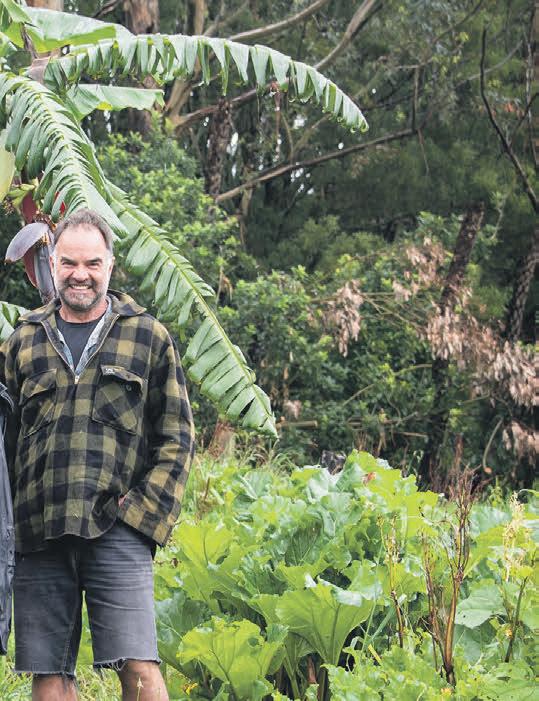










































































Here we go again.
at particularly unfunny chap who ddles with national standard time twice a year has just had his jollies again. When many of us were enjoying a deep, probably drink induced, night’s sleep early Sunday, April 2, the Time Lord slipped into his magic blue time box machine and took us on another extraterrestrial hour long trip.
Next morning, I watched the cows yawn as they pondered whether clocks had moved forward or backward and whether they should make a move towards the herringbone. Or perhaps they should have been there an hour ago.
See – it’s a mess.
I tried to explain to them there would be a schedule adjustment to meet the milk truck pick up. But they just stared me all doe-eyed and disinterested.
I blame that busy-body pom William Willett who rst proposed daylight saving time away back in 1907.


Taking advantage
“A way to take full advantage of the day’s light,” he said. Why did we buy into that?

I have never even tried to gure daylight saving time (DST) because what William Willett started, Mr iPhone now does it for me. Does it automatically. DST might motivate a few ‘urbans’, the townies, to get some added outdoor recreation, an evening run, an extra nine holes, or an espresso martini on e Strand. But as a person of the soil, my circadium rhythms are now all to hell and my days screwed. I don’t need DST nor do I want it.
I have also never gured how DST saves anything –let alone daylight.











Doesn’t DST simply change the time on clocks when the sun rises and sets. It doesn’t create or save anything. When DST was foist upon us it was argued

more daylight meant less use of arti cial light and consequently more energy savings. However, modern society with its penchant for 55, 60 and 65 inch televisions, computers and air conditioning would have sucked any skerrick of life out of that argument. In fact, in Indiana when they introduced DST in 2006, a study found energy use actually increased.







DST has been around for a 100 years in various parts. And I feel like we have been grumbling about it for as long. But it was pointless grumble, and any of the time I am meant to have saved has been wasted.
ere’s also all the hocus-pocus “evidence” for and against DST. Studies link lack of sleep at the beginning of the day to car accidents, workplace injuries, suicide and miscarriages. e early evening darkness at the end of DST is linked to depression. I am getting glum just processing all the nonsense. e risk of heart attack is also increased when DST begins. However the extra hour of sleep we get at the end of the DST has in turn been linked to fewer heart attacks.
Safety is apparently a ‘solid argument’ for keeping lighter evenings. DST improved road safety by reducing pedestrian fatalities 13 percent during dawn and dusk hours. And another study showed a seven percent decrease in robberies following the spring shift to DST. Tell that to the ram raiders. ere’s also a reported decrease in productivity after the spring transition. I feel some post DST lethargy coming on as well.
Interesting that in the USA states can opt out of DST. It’s the same in Queensland. Do you think the rest of the country would notice if New Zealand farmers, and their cows, arbitrarily opted out of DST too?







•
•
•
•
•
•
•
•
available this season provides an opportunity for the industry to focus on improving fruit quality which will play a key role in returning more value to growers and communities.



“ e industry’s Quality Action Plan was launched in October last year and has seen signi cant collaboration throughout the entire industry to ensure we deliver great quality fruit for our customers and consumers in the 2023 season, as well as in the years ahead. at starts with
ensuring that we’re doing everything we can to have a great harvest and looking after the fruit throughout the supply chain. ere’s already been some great work undertaken across the industry as part of the Quality Action Plan, and that will continue to be our focus as harvest continues over the coming months.”
One of the key principles within the plan is assessing fruit ow decision-making from end-to-end, and Jason says that includes looking at how Zespri can optimise its shipping programme.
e rst shipment of the 2023 New Zealand kiwifruit season is expected to reach Tokyo early this month.

Around 2500 tonnes (more than 600,000 trays) of Zespri SunGold Kiwifruit departed the Port of Tauranga on March 20, heading to customers in Japan.

e Southampton Star is expected to reach Tokyo in early April before sailing onto Kobe and is the rst of 53 charter vessels Zespri will use this season to deliver around 145 million trays of Green, SunGold and RubyRed Kiwifruit to more than 50 countries.


Charter vessels will be responsible for delivering around 72 million trays of this season’s New Zealand-grown fruit to Zespri’s global consumers. is season’s charter programme will include three services to Northern Europe, seven to the Mediterranean, two to North America’s West Coast and 41 to Asia, with a further 73 million trays to be shipped using container services.
Zespri acting chief global supply o cer Jason Te Brake says after a really challenging 2022 and a tough start to 2023 given adverse
weather events including Cyclone Gabrielle’s impact in Hawke’s Bay and Gisborne - the start of the new season represented a reset for the industry.

“Demand for our fruit remains strong, and with this season’s harvest ramping up over the coming weeks, we’ll soon move into mainpack where the bulk of our fruit is harvested. It’s a proud moment seeing the rst ship taking our fruit to customers and consumers but especially this year given it’s been such a challenging start to the year for some of our growers.”
Jason says lower fruit volumes and having more labour

An outbreak of avian botulism in Waikato’s Whangamarino wetland that has killed thousands of waterfowl including some rare indigenous species is yet another wake-up call for urgent action, says Fish & Game New Zealand.
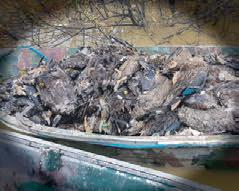
e latest outbreak of the deadly bacteria, which produces a toxin that can paralyse and kill birds, follows multiple and increasing outbreaks during summers in and around the Waikato region over the past decade.
Poor water quality and changes to water ows as a result of human activities contributes to low oxygen levels, creating the perfect growing conditions for this bacteria, says a statement from the environmental organisation. is results in sh dying, followed by birds before the botulism spreads to other surrounding wetland environments.

Covering almost 7000 ha in Waikato, Whangamarino wetland is recognised by the Ramsar Convention as a signi cant global wetland worthy
of protection and conservation.
It is the second largest freshwater wetland in the North Island and was chosen as one of three nationally signi cant wetland sites in the Department of Conservation’s Arawai Kākāriki wetlands restoration programme.
Fish & Game New Zealand chief executive Corina Jordan says the outbreak is an appalling situation.

“ is has had a massive impact on sh and bird populations in these wetlands, and we have grave concerns for the welfare of the wider bird populations in the area. “Parts of this wetland have been without oxygen for the best part of three months, leading to massive aquatic deaths of even the hardiest freshwater species such as eels. is isn’t normal in healthy freshwater wetland systems.
“ ere have been long-term systemic failures in freshwater policies and a lack of implementation that has caused severe degradation in our freshwater ecosystems.” Degradation of waterways and associated environments, coupled with predictions of longer hotter summers, means these types of botulism outbreaks are likely to become more common, says Corina.

Ex-dairy farmer, Otto McGirr, sensing a change in consumer habits, saw an opportunity to move into free-range poultry farming in 2011.
Fast forward to 2023 and Otto is running a 48,000-hen cagefree operation with his daughter Karlene McGirr and her partner Jim Brown.
In early 2020, as Covid crept into Europe, Karlene and Jim were doing their big OE and living in a van on the beach in Croatia.
“A Croatian medical friend warned us to get back to New Zealand as soon as possible,” says Jim.

ey managed to get back into the country 24 hours before the rst New Zealand
lockdown in March 2020 and completed isolation in a shack on the farm.
“During the peak of Covid we worked on the farm to help Otto, fully intending to return to Europe.


“But Covid didn’t blow over, so we sold the van and joined Otto in expanding the poultry farm.”
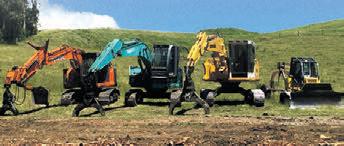

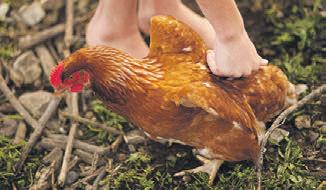

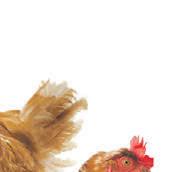




Otto’s Egg Company supplies locals with healthy, free-range
eggs. His rst few sheds housed 8000 hens which roamed over several hectares for up to 16 hours a day.

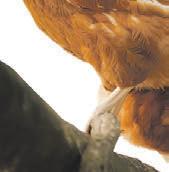
After a few years under
their belt, the family decided to increase the infrastructure on the 50-hectare farm. Otto’s has grown to 48,000 free-range hens, and some open barn hens and 13 full-time sta oversee the operation.
More recently, Otto saw the demand in locally produced food and wanted to highlight that eggs are being produced right here and available in the Bay of Plenty and the Waikato.
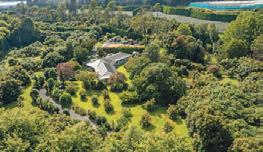
ey came up with Kaimai the hens. Otto felt it wasn’t right
Kaimai Eggs, with their brand and retail packaging re ecting who and where they are.



“We sell to the retail sector under Kaimai Eggs and are passionate about the welfare of to put animals in cages and we feel good about giving our birds this freedom.”


continued...

e family enjoys the challenge of owning the whole supply chain, from rearing one-day old chicks right through to grading and packing of around 42,000 eggs a day on site, and delivering to supermarkets, restaurants, cafes and wholesalers all directly from farm.


Jim readily explains why free-range eggs cost more. “ e hens are out foraging all day in the bush and expend more energy than a caged hen, so they eat more food. Contrary to belief they don’t get lled up by foraging for bugs and grass and they need a quality, balanced diet to stay healthy and produce top quality eggs.
“ ey use more of the available land and infrastructure, and production is lower on a free-range farm.”



Add in the fact that the hens are more at risk from disease when their diet is less controlled, and their mortality rate is higher from predators such as hawks, Jim estimates that free-range poultry farming costs around 20 per cent more, and that is re ected in higher prices.
A hen’s laying life is 80 weeks and Jim says they also take responsibility for the culling.
“ e hens have provided us with a business, and we don’t want to pack them o live to a stressful unknown end. We swiftly cull them ourselves, during darkness when they are asleep.
“For us it is tting that we complete the process ourselves.”

e family are passionate about local food and “want to be right in the middle of it”. eir weekly presence at the Hamilton and
Cambridge Farmer’s Markets allows them to connect and talk with their consumers, openly discussing the processes that lead up to the eggs being in a box.




Jim is grateful that their business structure allowed them to come through Covid in good shape.

While their wholesale and restaurant sectors declined, their supermarket sales substantially increased as people in lockdown baked and cooked.
Ten years ago, the government announced changes in legislation to phase out the caged hens by the end of 2022.
“New and existing poultry farmers invested in new sheds and set ups that met the proposed colony shed standards, but the old sheds were still running. is caused an oversupply of cheap eggs, which for a few years meant poultry farming wasn’t particularly pro table.”

Many farmers couldn’t get nance to change their sheds over as the banks were reluctant to lend to a low performing business.
When the end of 2022 came, there were not enough colony, barn and free-range poultry up and running to cover the 25 per cent drop in production caused by closing the caged hen farms.
“ is has resulted in a temporary egg shortage and has taken a source of cheap protein out of the market, which hits some families hard.”




Despite everything, Jim describes their demanding job as “bloody rewarding and we love running around with chickens all day providing families in the Bay of Plenty, and Waikato a healthy food”.



Last summer it was drought, now oods have ravaged crops around the country - and growers say vegetable price hikes are the likely result.
Shon Fong says February’s deluge was the worst rain he’s seen before. His family business, AH Gorn & Sons, has been based in the Pukekohe area since the 1950s.
“It was continuous for 24 hours and the ground just couldn’t take it,” Shon says.



His elds have lines gouged out of the soil by ood waters. Fong said onions, which had been harvested and left in the open to dry, were left strewn across the paddocks and an adjoining road.
“We’ve lost about 20 per cent to 30 per cent of our harvest.”



He says after last year’s drought, it’s hard to take.
In May last year, the Ministry of Primary Industries declared the drought a “medium-scale adverse event” in south Auckland and the Waikato and announced a support package for a ected farmers and growers.


e unusually dry conditions made it challenging for those in the industry, with falling yields and increased overheads to pay for irrigation.
“We’ve gone from one extreme to the other.”

South Auckland’s horticulture industry centres on the Pukekohe Hub, 4359 hectares of some of New Zealand’s most fertile and productive land.


According to Auckland Council’s 2019 Climate Action Framework generates $327 million a year - the equivalent of 26 per cent of NZ’s total domestic value of vegetable production.
Shon says he’s convinced the latest ood damage in Pukekohe will lead to an increase in the price of all green vegetables, potatoes and onions.
“A lot of them have been under water and they won’t be able to harvest them.”
Jivan Produce director Bharat Jivan has

been outspoken about the ongoing e ects of climate change on the industry. e Pukekohe-based family business has been operating in the area for 60 years and grows potatoes, onions, lettuce, broccoli, cauli ower and pumpkins.


“Last year we had a drought and this year we’re getting endless rain,” he says. “We are going to have to deal with climate changethere’s no doubt about that.”
But Bharat says his own business wasn’t as a ected by the ooding as other market gardeners in the Pukekohe area.

“Some growers had the ood water go right through their crops.”
Bharat says Pukekohe’s market gardeners will adapt, despite the latest setback. However, he said an increase in vegetable prices after the rain and ooding was a very real possibility.
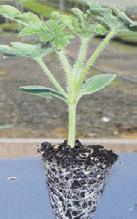
that had been left to dry in the elds were strewn across paddocks and roads.
e 2023 passionfruit crop has survived the devastation of Cyclone Gabrielle and is arriving in stores.
e country’s small team of commercial growers based in subtropical areas such as Northland, the Bay of Plenty and Taranaki pleased to deliver these tasty seasonal delights to consumers.



A real delicacy, passionfruit are a labour-intensive crop that require careful management throughout the growing season.
New Zealand Passionfruit Growers Association president Debbie Baxter says this season has been a particularly challenging one for growers.

“Like many other growers, we faced di cult weather conditions throughout the season.

“Many of our growers were a ected by the severe frost in October and the vines have taken some time to bounce back from that.
“While we haven’t lost a large amount of fruit, the lack of sunshine hours this summer has delayed production by as much as four weeks in certain areas.”
Debbie says getting passionfruit to shoppers is a delicate balance that requires a lot of care and expense.
“Growing passionfruit is a real labour of love. High costs are incurred from pruning and daily




picking for months. Passionfruit vines are prone to disease, and, despite careful management, we have a high rate of replacement for plants that have died. In the past year alone, some of our growers lost 100 per cent of their vines, while others left the industry altogether.”
Plant & Food Research principal scientist and 5+ A Day Charitable Trust spokesperson, Dr Carolyn Lister says passionfruit provides signi cant nutritional value for their size.
“ e cost of two passionfruit equates to a cup of co ee – but at the same price, passionfruit delivers the nutritional bene ts of dietary bre to keep your gut healthy, and powerful
antioxidants such as vitamins C and E to support your immune system. Plus, their intense sweet and tangy avour is unbeatable.”
5+ A Day suggests that passionfruit are perfect scooped out and eaten as is or added to a wide range of sweet and savoury dishes.
Passionfruit can add a tropical twist to salads. Add passionfruit pulp to a dressing for a classic green salad or mix the pulp with chunks of cucumber and peach, add baby spinach and cherry tomatoes and drizzle it with chilli and lemon for a deliciously sweet and spicy combination. Make the most of this season’s passionfruit which are in stores from March through to September by trying out some of the tasty recipes on the 5+ A Day website, www.5aday.co.nz, or by following them on social media channels for more great ways to use this tropical avour bomb.
Shane Rush and Nicki Murray-Orr are living on six-and-a-half acres on the outskirts of the Karangahake Gorge near Waihi.



Both are interested in taking responsibility for providing as much of their own food as they can, and living lightly o the land. e principles of permaculture have provided the framework for the design of their land and home.
Nicki works as a gardener and runs edible gardening workshops, based on permaculture principles. Shane, a builder, is involved with Vital Harvest, the couple’s permaculture consultation and design business. ey specialise in domestic gardens and lifestyle blocks with the aim to inspire and educate others to grow food, build resilience and utilise their land.

“I was brought up in Auckland, but always wanted land after spending holidays on my Uncle and Aunty’s farm in Dannevirke,” says Shane. Despite growing up on a farm in Gisborne, Nicki worked in investment banking in London and New York and recruitment when she returned to New Zealand.


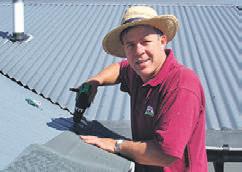
“On an acre in Waihi, we grew veggies and fruit trees, but it was starting our family and reading a book about raising healthy kids on nutrient-dense food and avoiding processed foods that really opened our eyes to how we wanted live.
“We discovered permaculture, which really










appealed to us, and bought our current block in 2016, full of plans to live more sustainably,” says Shane. e couple designed their house themselves and Shane built it while the family lived in tents on the property for around four months.
A solar passive house relies on utilising the sun for warmth in winter and minimising summer sun to keep it cool in summer. Winter vegetables store for months in the specially-built cool room on the south side of the house.
“ e house had to be north-facing, have high thermal mass concrete oors, minimal windows in the western walls, and lots of north-facing windows,” says Shane.
...continued
She has an extensive veggie patch that feeds the family year-round. ey eat very seasonally, so rarely have to buy vegetables. e garden is colourful and lush with owers planted throughout to bring in the pollinators and bene cial insects. She uses minimal cultivation and makes her own compost and mulch for the garden. e focus is always on the soil – as healthy soil is

important for healthy plants, and ultimately healthy people. Berry patches, nut and citrus orchards are continuing to be developed. e property has three 25,000L water tanks and a 3000L water tank for roof rainwater. A pond has been dug out that is fed by a weak spring and also catches water from the property. Excess water drains into a newlyplanted wetland.
e 140mm by 45mm framing maximises the high R value insulation in the walls and ceilings. Mindful of their future needs as a family, when their two teenage children have left home, the threebedroom corrugated iron-clad house has a modest 180m2 footprint.
A wood- red stove and hot water heater also runs several radiators.
“We are growing our own rewood trees using coppicing as a way of managing the woodlot but it takes time to establish a sustainable eight year rotation,” says Shane.
Coppicing is a traditional woodland management technique involves felling trees at their base to create a ‘stool’ where new shoots will grow.
While doing a part-time permaculture course, Shane was able to use their land for his design project. ey are still working from the meticulously hand-drawn plan.
Specialising in
biology and boost soil health.

Feeding the soil microbes has huge bene ts to pasture health, which ultimately bene ts animal health, says Shane.
“We don’t use mechanical cultivation and we spray using organic Agrisea soil conditioner and pasture nutrition.

“Our pasture is fairly diverse already but we are always looking at adding more options.”

e food forest design uses nature as a guide. e aim is to mimic what would naturally occur in a forest setting but deliberately use edibles as the majority of the forest species. It’s planted with a diverse array of plants including support trees, ground covers and mineral accumulators that complement the fruit and nut trees, herbs and vegetables.
Plants such as tree lucerne grow fast, support young trees, x nitrogen, provide stock fodder and can later be used as rewood and mulch. ey are a great support tree. Ideally the food forest becomes a self-supporting system.
Removal / chipping of whole trees
e land currently stocks six cows, six sheep, two pigs, ve chickens and a friend’s beehives. It is holistically managed with the beasts shifted daily onto new breaks. ey only eat a proportion of the pasture, depending on the season and the rest is left to break down into the soil to feed the
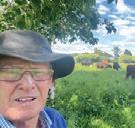

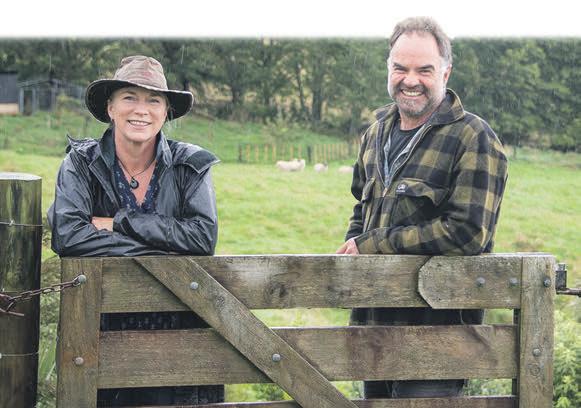
“ e soil is critical and we try and keep all dead material within the forest to feed the soil, which helps to encourage the presence of fungi,” says Nicki.
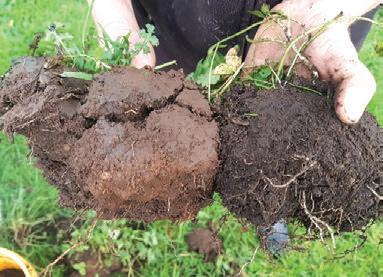
On site chipping for stand off pads
Wood chip for sale
Orchard shelter removal
Stump removal
Woodlot marketing of all tree species
Specialising in




• Removal / chipping of whole trees
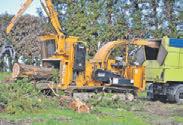
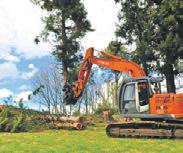
• On site chipping for stand off pads
• Wood chip for sale
• Orchard shelter removal
• Stump removal
• Woodlot marketing of all tree species

Contractor milker Danielle Hovmand is demonstrating a strong desire to further her knowledge and experience in dairy farming, and has her eyes rmly set on the progression to farm ownership.
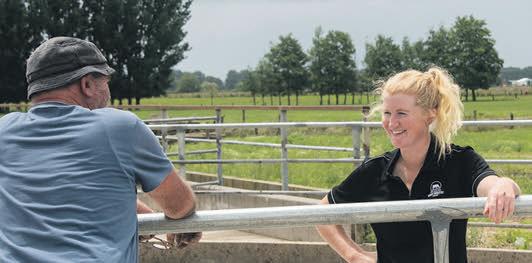

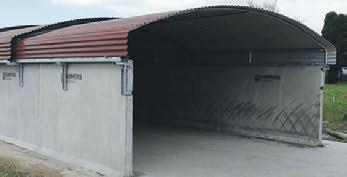
e 26-year-old took home the Sharefarmer of the Year Award at the 2022 New Zealand Dairy Industry Awards for the Auckland/Hauraki region, along with six of the eight merit awards on o er.

“My parents farmed until I was seven, and I spent huge amounts of my childhood at my





grandparents Hereford stud in Katikati, so it seemed natural to go into farming,” says Danielle. She started with a degree in Ag. Science at Massey and worked on a dairy farm for the rst time for one of her placements. is led to holiday work during her degree and a full time job as a junior farm
manager for two seasons after her degree.
“My next role was with Sue Broom eld, as a contract milker near Patetonga, where I milked 270 cross bred cows on 106 hectares under a Production System 2.
“I was there for two seasons and Sue suggested that I entered the 2021 awards to get a feel for them.”
Danielle didn’t feature in those awards but she “knuckled down” and spent the summer prepping for the 2022 competition. She “really wanted to win and have the experience on her CV” as she felt that it would help people take a woman farming on her own more seriously and show her capability.
e DairyNZ - People and Culture Award identi ed Danielle’s move to the Waikato and her e ort to become part of that community.
“I joined the Morrinsville/ Ngarua Young Farmers which has 50 members and is very active socially. It was a great way to meet like-minded people and I met my

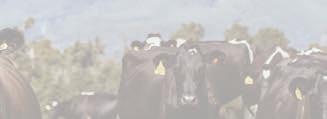

partner Harry there.”
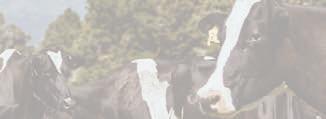
Danielle has since become vice chairman and is involved in organising fund raising events. Her Ecolab Farm Dairy Hygiene Award re ects her meticulous record keeping in her dairy diary.
“Sue Broom eld once said to me that ‘your cowshed is the window into your farming operation so keep it looking good’, and I have taken that onboard. I record everything from animal health to grazing plans, and e uent use to farm maintenance.”


e Honda Farm Safety, Health and Biosecurity Award acknowledges Danielle’s use of the Orange Cross app. is app includes her risk register, and is used for recording incidents and accidents, which contractors can view.
“Because I work on my own I am very mindful of health and safety and the balance between taking enough time o not to be fatigued but keeping my systems e cient.
“I take extra care not to take any unnecessary risks around the farm.” ...continued

Although Danielle is the contract milker, her partner Harry, who is an ex-dairy farm manager and completing his building apprenticeship, helps out daily and at weekends.
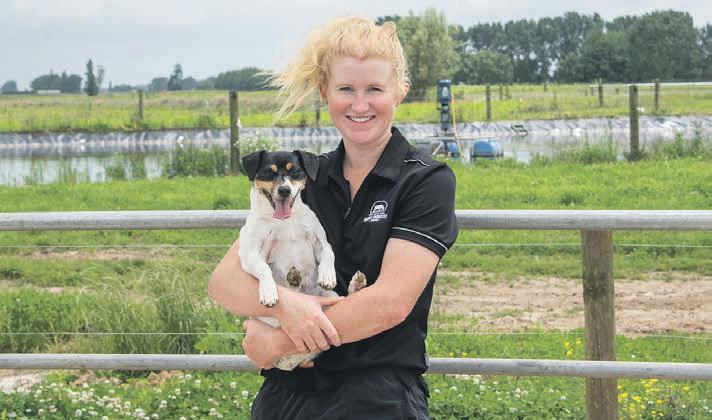
e Meridian Environmental Sustainability Award meant a lot to Danielle. She strives to look at the farm business as a whole when considering sustainability and the farm environment.
“It’s not just about now but about the environment I leave for the future farm owners.”
As she’s not a landowner herself, she happily runs ideas past her employers and successfully applied for funding
to plant out the riverbanks at Sue’s Patetonga farm.
Danielle sees pasture as the key to how she makes her money through farming and this won her the Ravensdown Pasture Performance Award.
“I do regular farm walks and record and monitor continually.

“I spend time communicating with our farm consultant and Sue so we make the right decisions for the farm, and I am always learning.”
For her Auckland Hauraki DIA Business Performance Award, Danielle was commended for her nancial dedication to her career path. She paid much of her student loan o by working hard
in the uni holidays, is thrifty with consumer items and has concentrated on slowly buying her own gear and equipment for becoming a sharemilker.
“ at way I will soften the initial costs of starting up!” She has also been investing in shares and carefully monitors her net wealth.


For the 2022 season Danielle moved to another of Sue Broom eld’s farms in Springdale as a contract milker.

“It’s still a System 2 farm, also with 270 cross bred cows, with more productive land and utilising in-shed feeding
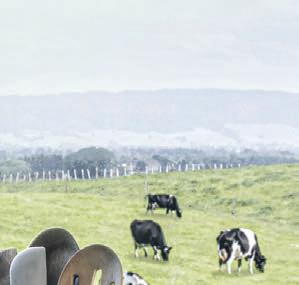
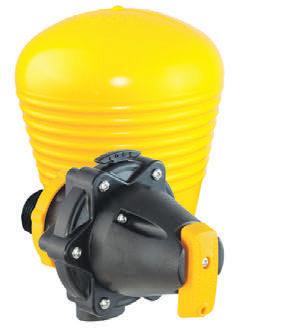
Danielle
resulting in an extra 10,000 kg/MS, giving a higher income.”



e Patetonga farm had clay soils and required a lot of damage control policies in place when wet, whereas this farm is on sand which has widened her experience.
For the 2023 season, Danielle and Harry have secured a sharemilking position, where Danielle will take the lead on the farm, and Harry will continue with his building apprenticeship and earn o farm.
You can say for sure, when it comes to quality and performance, Boehringer Ingelheim cattle products will keep your stock at their very best. Equally, this cookware by Zwilling is known to outperform expectations and designed to handle any recipe for success. Receive


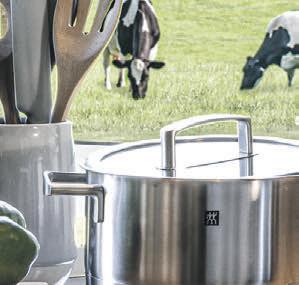


Ingelheim cattle products this season.

We often talk about the power of nature but our inability to withstand its extremes has never been more evident than in Cyclone Gabrielle.
ere is nothing I can say which will lighten the tragedies and challenges handed out to communities across Hawke’s Bay, Gisborne, East Cape, Coromandel, Auckland and Northland. e trauma they have su ered is beyond comprehension and the only remedy is to rebuild. at



will take huge amounts of time, manpower, skills, machinery, money and support. In farming we are accustomed to challenges we can see an end of, but the scale of this disaster means that it’s impossible to put a time-frame on the recovery to ‘normality’.


So while our minds might be on all the people a ected by Cyclone Gabrielle, the reality is that for most of us, our energies need to be devoted to getting on with the job at hand
orchards, businesses and homes.

On our blocks, at the time of writing this article, we haven’t begun harvesting maize because it’s simply not ready yet. In a normal year we would have nished by March 15/20, but, due to lack of hot sunny days, the maize crops are not drying down. However, at least the crops are healthy. Driving around the area, we are seeing a lot of Northern Leaf Blight. is shuts the plant down within a matter of days.
Farmers who see signs of blight have only one recourse and that’s to apply a good quality inoculant and get the contractors in to harvest. It might be two to three weeks early but there is no time to be wasted. Harvest now! You will get diminished crops but at least you will have feed for winter.


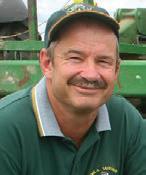
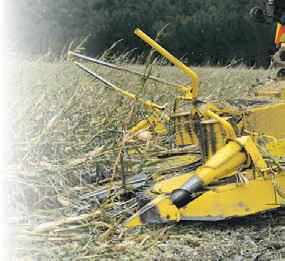
In the Waikato a number of maize crops have lodged (driven at) by the high winds of Cyclone Gabrielle. While at, they can still be harvested but it will be slow and the quality will be down because the plants are lying on ground, which is, in many cases, still waterlogged. NLB and lodged crops aside, there are still a lot of crops around which are still standing and unable (yet) to be harvested because the ground is too wet for machines to go over or aren’t ready yet. e days are beginning to close in so let’s hope we get some hot, dry days to mature crops and dry the ground so we can get much needed winter feed in. Another issue we have had is that many of our hay and straw orders were to come out of Hawke’s Bay. at is now impossible so we have had to go further a eld.
Our straw supplies, which sometimes come from the South Island, have been





severely impacted by the ferry debacle with trucks unable to get across the strait, having to park up, wait for an available crossing and then not always getting a berth. We just have to work with the system though – everyone is doing their best to restore services and we’re all in this together.
Our straw has arrived and is in the shed and we expect two loads of hay in the last week of March. I am con dent we will have stocks of grass silage, straw and hay for winter for sale.
Right now farmers need to be continuing with their pasture renovation – grass cover may be up but the real test is coming, in winter.





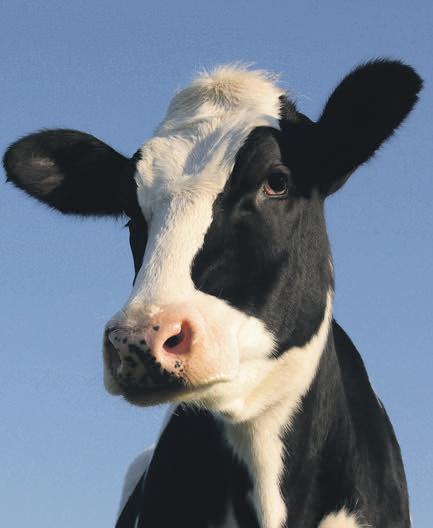
Every sector of the economy is under cost pressure right now and we have to hope that our industry, already under extreme pressure, isn’t further compromised by rising prices.
We are in this together and need to keep our eyes on the big picture – the revitalisation of our agriculture industry. Farming can be a solitary job but tough times call for reaching out to mates, even if it’s just on the phone, or over the back of the ute. Knowing you’re not alone with the challenges you’re facing is a huge strength when we are facing tough times. Every contact is morale building and it’s that, that will get us through this.
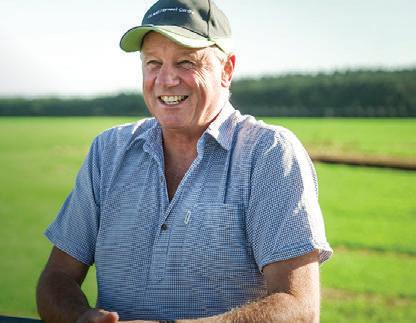
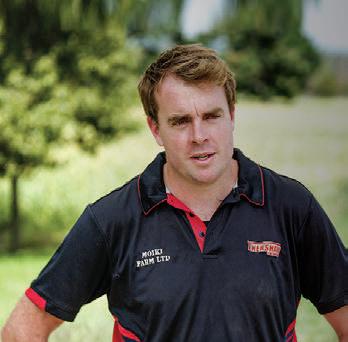
At the yard from March 1-13, we had 25ml of rain compared to 22ml the previous year, and at the farm 58.5ml compared to 1ml in 2022. e picture is clearer when you go back to the start of the year (January 1 to March 13) when, at the yard, we had 498ml compared to 246.5 last year, and at the farm a whopping 1321.5ml compared to 229ml in 2022.

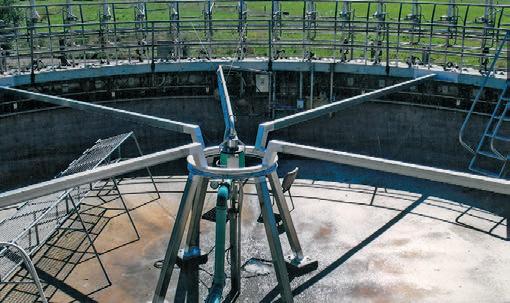
Average temperatures are constant with 20.2 degrees at the yard (March 1-13) this year compared to 20.7 degrees last year.
“YOU DON’T REALISE HOW MUCH BETTER HAVING A JCB TELEHANDLER



Resilience is a word seen more frequently nowadays and our understanding is that it means the ability to stand up again after being attened, both guratively and literally, and our thoughts are with those in the Hawke’s Bay, Gisborne, Northland and East Coast regions.

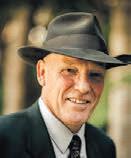
Rural communities are landbased and the damage to land cannot be underestimated with the impact on individuals and communities unimaginable for those of us not directly involved.
Where we are able to assist is with the recovery of land. We subscribe to the philosophy that natural systems tend to wellness and left to time without intervention damaged land will recover, however there is much that can be done to speed the process.
Some of the steeper country is likely best planted in trees and possibly not grazed again, however it is under grazed permanent pasture that carbon is most rapidly sequestered and carbon in the form of organic matter is more valuable than gold as it is the essence of our survival. As carbon is sequestered and organic matter built the potential for increased plant growth steadily grows.
e grazing of plants stimulates further growth.
Dung and urine are deposited and along with uneaten leaf an organic cycle starts to operate, slowly at rst but with sound management the speed of cycling steadily increases.
e other contributor to soil organic matter is old root. When a plant is grazed a process of root pruning takes place.

e discarded root is digested primarily by earthworms, here in New Zealand it’s usually the humble but highly e ective allolobophora caliginosa.
ere were never naturally occurring grasslands producing anywhere close to the annual feed supplied by today’s high producing clover-based pastures.
e pastures that provide much of the meat and milk necessary for our survival were developed by early settlers with a quantum step forward provided by the application of superphosphate after the second world war when DC-3 aircraft were used to spread it over recently cleared hill country.
Creating the environment that allowed clover and higher fertility grasses to ourish allowed astute and hard-working farmers to build stock numbers with a



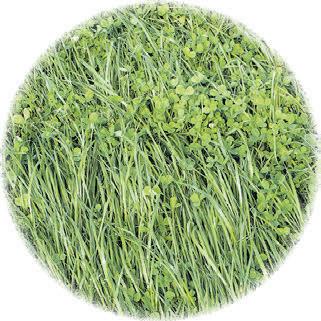
consequent increase in soil fertility.

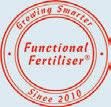
Inevitably some steeper country that is prone to slipping and at best marginally economic will be retired and whether planted in harvestable trees, manuka, or a variety of other species is yet to be decided.
e silt that has been deposited in the bottom of the valleys will in time develop into highly productive soil capable of supporting animals and horticulture providing essential food for people. Permanent clover-based pastures require, along with regular phosphorus and sulphur inputs, extra calcium as clover naturally contains three-four times the calcium of grasses. is is best provided by ag.lime with one of the bene ts often ignored being the subsequent increase in earthworm numbers along with the activity of a wide variety of bene cial fungi and bacteria. Land damaged will recover more quickly when bene cial fungi and bacteria are introduced in much the same way as the human gut bene ts from a probiotic after a course of antibiotic. Functional Fertiliser developed two products, CalciZest and DoloZest, more than twenty years ago that contain a wide range of bene cial fungi and bacteria.
ey were formulated to speed the rate of nutrient cycling and improve physical soil structures. In order to ascertain their e ectiveness they were initially incorporated into total nutrient programmes and the outcomes measured.



Over more than a decade of monthly pasture cuts a lift of 30 per cent in annual pasture production without reliance on synthetic nitrogen was a common nding.

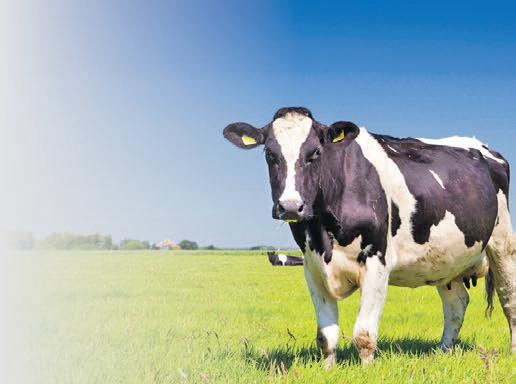
Because the slow growth winter period is the time during which all accumulated organic matter is fully digested providing nutrient for rapid spring growth, autumn is the optimum time to apply either product. For more information call Peter on: 0800 843 809.
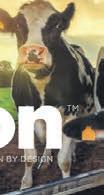
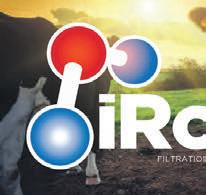

e masthead might be new but specialist chiller company, Chill2Go, has more than a decade of experience providing specialist refrigeration engineering services to New Zealand’s commercial, rural and residential sectors.




Chill2Go, a subsidiary of CPR Refrigeration and Air Conditioning, was formed to provide specialist chillers across New Zealand.

Company director Nick Papa says the Taupo-based company supplies chillers speci cally designed and manufactured to meet the demands of the country’s farming, hunting
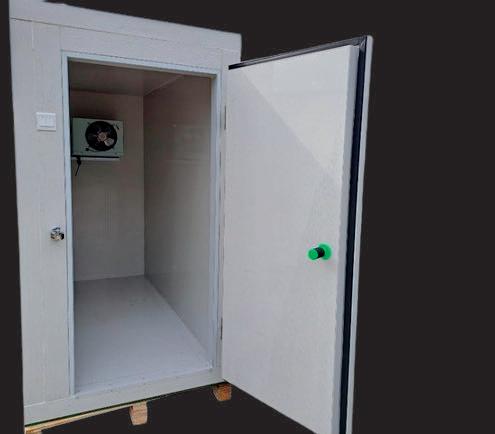
and commercial sectors.
“All our chillers are made to meet New Zealanders requirements and each comes with the reassurance of 24/7 service from our team of experienced refrigeration engineers.
“Whether you are a farmer looking to protect the quality of your meat, a restaurant owner needing to keep ingredients fresh, or a consumer looking to store frozen items, Chill2Go has you covered.

“We are equipped with state-of-the-art refrigeration systems that will ensure your goods are kept at the correct

temperature, preventing spoilage and waste. And we back that up with the reassurance of 24/7 servicing so you never need to worry about outages.
“Our specialist team is able to recommend the best refrigeration system for your




needs be that split or monoblock, and we have a range of ownership options so you can either purchase or hire the right unit for your home or business.
“Chill2Go’s head o ce is located in Taupo but we deliver and can arrange service across New Zealand.”
Two Aongatete farmers have been convicted and ned a total of $28,000 for discharging dairy shed e uent to land where it entered a tributary of the Aongatete estuary.
Bay of Plenty Regional Council prosecuted Francis Nettleingham and John Nettleingham for the discharge of dairy shed e uent that occurred on their Aongatete farm on October 13, 2021.
e farm operates as a small calf-rearing enterprise, milking about thirty cows to feed the calves. Both men were ned $14,000 each.
Dairy e uent has high nutrient, ammonia and bacterial levels.
Nitrogen levels were above the identi ed protection values, toxic to sh and other aquatic life.
Contamination has cumulative e ects on Tauranga Harbour contributing to algae blooms and a
heightened health risk to recreational users.
“A relatively simple system for diverting stormwater and cowshed e uent to appropriate destinations was not operated properly,” says Judge DA Kirkpatrick.
“ ere does not appear to have been any fault or problem with the elements of the system, only with the way in which the defendants used it.”
“ e Aongatete estuary has high cultural and ecological values,” says council compliance manager Alex Miller. “Everybody has duties and responsibilities to manage their dairy shed e uent to avoid unwanted pollution entering the environment. Regardless of the scale of the farm and dairy operation, farmers need to put the design, operation, maintenance and inspection of their e uent management systems at the forefront of their work.”

Over the last little while we have seen house and section values reduce from the peak seen in early 2022.
It’s no wonder, with the Reserve Bank rising the OCR and threatening us all with a recession. People simply can’t or won’t borrow enough money to pay those high prices right now. So sales and values slump and people tend to put their plans on hold. History tells us that this can’t last forever and the cycle will reverse again. Interest rates will fall and demand will come back – possibly only two years away according to some predictions.

So, I hear you say, what’s this got to do with subdivision and land development? Well, you may be surprised but the process that you need to navigate through to subdivide your land and create the sections that are going to be in demand can take a similar time. Our clients taking action now could, in a couple of years, be in a position to sell sections in an environment of falling interest rates and rising prices with people having the capacity to borrow again.

Getting resource consent to subdivide from your local council can take many months as they work through the intricacies of the Resource Management Act. Councils seem to be taking more and more time

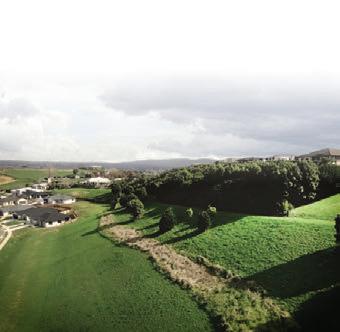
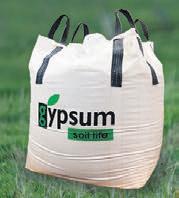




these days and asking for a whole lot more information in the process. is could get worse before it gets better with new legislation on the horizon. at in itself is a good enough reason to start the subdivision process as early as possible.






To prove to your council that a subdivision is viable we need to source reports from many experts in elds such as geotechnical, drainage, ecological, and tra c engineering to name a few. All this must be carried out before applying to the council for Resource Consent.

Following consent from the council there will be construction required for drainage, electricity connections and driveway entrances to name a few. is all takes increasing amounts of time in a stretched economy where much focus is going on repairing and upgrading roading and other cyclonedamaged infrastructure. We are not expecting the time frames for construction to improve any time soon, so the sooner you start the sooner you get your new titles.
If you have any thoughts about subdividing over the next few years, there may not be a better time to talk to the subdivision experts. Feel free to give us a call for a heads-up on the possibilities.

Strong soil is more resilient to erosion and weather events and decreases fertiliser application. It all starts with microbiology.
Adding biological products to your soil:
•Positively impacts yield (more fruit and vegetables!)

•Forms soil aggregates – helps the soil stay together, reducing the loss of valuable topsoil (reduces erosion!)
•Improves the use of applied fertiliser and native minerals, particularly phosphorous, this means you can apply less (save money!)

•Resilience – the more robust the plants, the more resistant they are to pests and pathogens.

e Organic Products and Production Bill began going through Parliament in 2020.
If accepted, it will help with developing new standards for organic products.
It would set requirements for most businesses involved in the organic sector, from production through to sale.
e purpose of the bill is to:


- increase consumer con dence in buying products labelled “organic”.
- increase certainty for businesses claiming products as organic.
- facilitate international trade in organic products.



e national organic standard will set the production and processing rules for products labelled as organic, and any requirements that are speci c to the products covered by the standard. Meeting the standard will be mandatory for anyone wanting to call their products organic.
e standard will be made into law through a combination of regulations and notices.
e system will also include additional compliance and cost-recovery regulations.
ere are four key steps to getting approved as an organic operator under the new system:
- Have an organic management plan (OMP).

- Get a pre-approval check from a recognised entity.
- Submit an application for approval to MPI.
- Receive ongoing veri cations from a recognised

entity, to ensure that you continue to follow your OMP and meet the national organic standard.
Businesses who produce, process, sell, or deal in products they describe as organic must be approved by MPI.
e new regulatory system for organic products will have di erent impacts on everyone involved. e rules that will apply will depend on what you do (for example, growing, producing, processing, importing, or exporting organic products). Find out more: https://www.mpi.govt.nz/ agriculture/organic-product-requirements-in-nz/ changes-to-organic-products-law/

growers and farmers of Aotearoa, New Zealand have experienced exceptional challenges this year and all indications show that we can expect more of the same. Sounds gloomy right? But we are optimistic about the future and believe wholeheartedly that we can recover and rebuild.
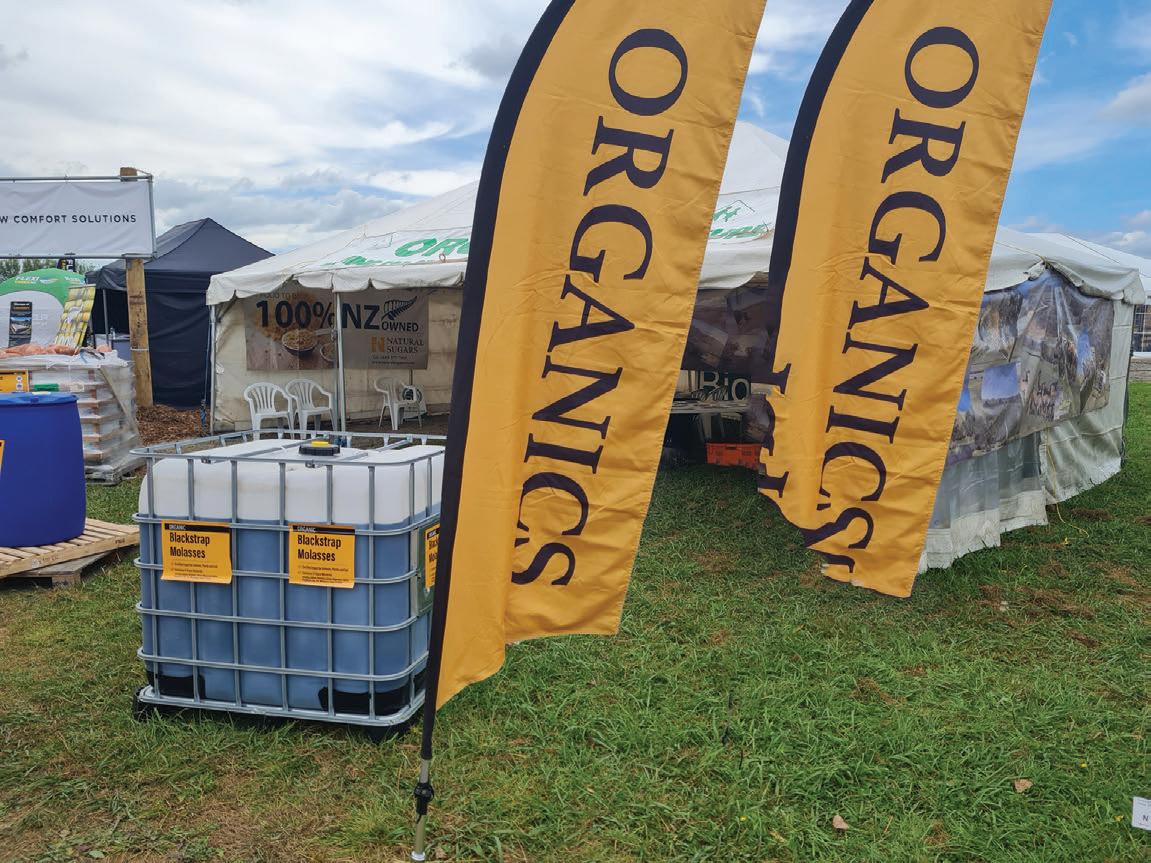
Anyone who has been growing or farming organically understands just how important it is to protect the health of your soil. We know that the loss of topsoil is a global problem and the need for organic matter and bene cial organisms to build healthy, productive soil is clear. Degraded and waterlogged soils mean less oxygen and nutrients for your plants.
One of the most important properties of soil is its ability to support a vibrant microbial ecosystem. is microbial biomass is responsible for breaking down organic matter and unlocking nutrients. Adding bene cial organisms, like Mycorrhizal Fungi, is a great amendment to help soil grow, recover and mitigate complications caused by extreme weather events.
Mycorrhizal fungi enables your crops to access a larger volume of soil for minerals and water by dramatically extending the reach of plant roots. is also means soil is more stable and able to withstand stress from both drought and waterlogging. Disease resistance is a bene t provided by bene cial organisms, not to mention the ability of mycorrhizal fungi to store carbon in the soil, locking it in carbon sinks deep in the earth.
It’s time to think of the big picture, to ensure we are all better o .
If you have questions, please feel free to contact us or view our products at rd2.co.nz
Organic farming has been part of New Zealand history since the early 1900s. Around 1983, the country formalised the independent validation of organic production claims.
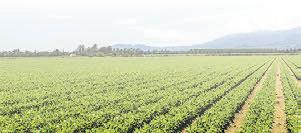
e Humic Compost Club, which became the Soil Association and then the Soil and Health Association, was formed in 1941.
Production
ose that recognised the importance of carbon in food production 80 plus years ago, must now wonder what took us so long to understand the carbon aspect in food value, soil health, environmental health and of course animal (including human) health.
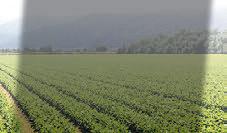
e third party validation of production system and inputs has opened the door to many world markets, many of these have developed their own market entry criteria, which we happily meet.
Each market has its own requirements, whether this is a 24 month or 36 month transition from standard chemical production systems, whether it covers food only or food/ bre and human hygiene and health products.
Some, such as the USA, allow for full backdating where it can be proven no prohibited inputs

are used during the previous 36 months.


e Commerce Commission in NZ administers the Fair Trading Act. is deals with all manner of ‘credence claims’: organic is such a claim, and most people understand the intent and know when mis-representation is afoot.






In the last 20 years, the Commerce Commission has dealt with only a handful of claims pertaining to organic.

e China NZ organic trade agreement also relies on the FTA, thus clearly showing its standing.
Currently, the NZ government is considering the Organic Products and Production Bill.
But the big question is, will it serve the organic sector or shut it down?
Over the past year or so we saw the introduction of new egg
production codes, the result is clear to see from January this year with a massive drop in eggs in retail stores as producers left the industry.
Will the same happen with organic law and regulation? Such clauses as warrantless entry and search, new levies, three year claw back for cost recovery, and the list goes on. e Bill does not have a clear and robust de nition of what constitutes organic production, it instead will be applied via regulation to all using the term organic.
At a time when central government is funding Re-Gen-Ag at both a research and certi cation level and the organic sector is forced to volunteer resources to aid in the
writing of regulation, most in the sector are dubious and one must ask what will the outcome look like.
e global consumer is looking for the complete organic food and bre products produced in NZ, not products that are a result of standard

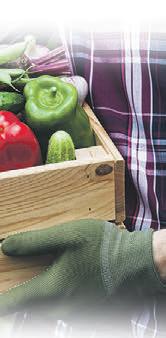
chemical production with a ashy marketing campaign.
We need to meet the market that pays and the organic sector has done this for four decades -40 years and counting.
Bill Quinn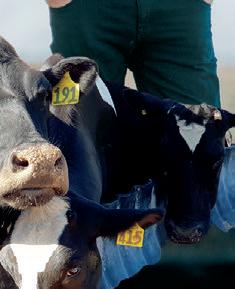
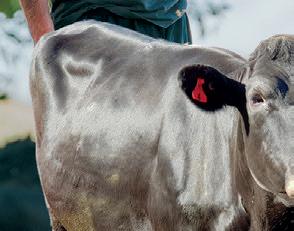

If you reduce stress levels in cows over calving, your stress levels will go down.
“Probiotics can do this,” says Probiotic Revolution founder Chris Collier.



“We know that by feeding probiotics to springers prior to calving, we are improving nutrition to such an extent that cows had more energy for calving and push out retained membranes.” e simple method of dosing springers via the water trough makes this treatment available to nearly all dairy farmers, so initial users give plenty of examples of ease of calving, less retained membranes, metritis and endometritis.
More recently, a Japanese study has given support to reports from farmers who have trough treated springers, says Chris.
“ e primary focus of this study was to show the e ect of a strong probiotic used pre and post





calving on mastitis. It signi cantly lowered the incidence of clinical mastitis and cell counts.

“In analysing how and why this happens blood samples were taken. Blood cortisol levels around calving were signi cantly lower - indicating less stress and in ammation.
“ ere is also a blood marker that shows up when a cow is using fat reserves, as happens when cows milk o their backs after calving.
“ is was signi cantly reduced in early lactation. is suggests that cows would rise to peak milk production earlier, and with reduced weight loss should cycle earlier.
“One farmer who took pre -mating heats while on our probiotic treatments had 95% of his cows cycling by the planned start of mating. In short, probiotics can be the missing ingredient to reduce stress and improving nutrition over the calving and early spring period.”
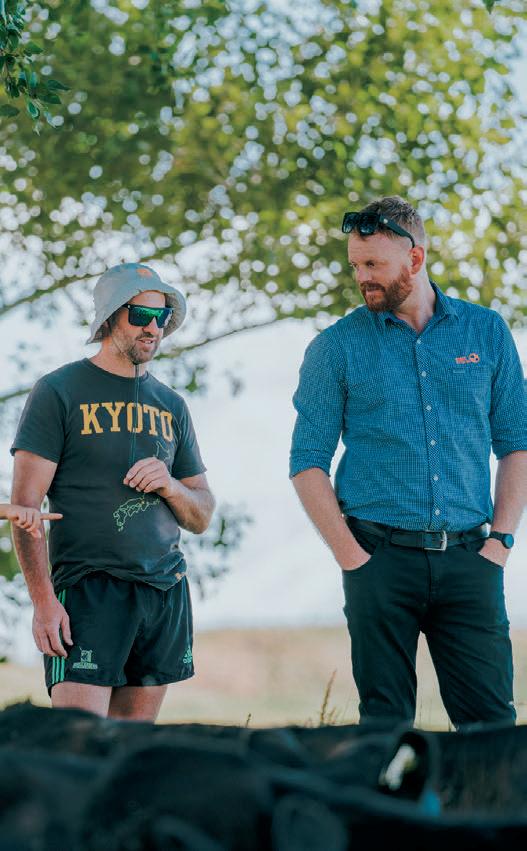








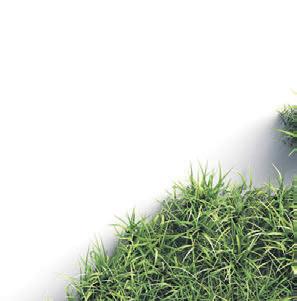

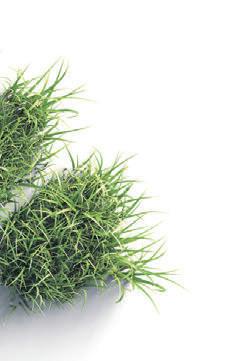






















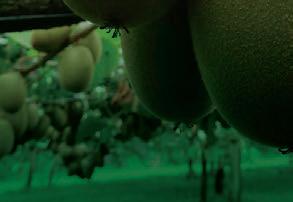
Since 2006, New Zealand Humates’ director Fred Harvey has seen increasing interest from farmers and growers in the organic space looking at humic products to improve soil biology and nutrient uptake.
Fred says Humates is a completely natural and organic substance, rich in carbon, humic and Fulvic acids; perfect for building up soil organic matter and is widely regarded by agronomists as one of the most important factors in building soil fertility.
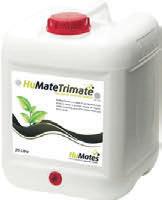
“Humic material has the ability to assist natural fertiliser applications become more e cient and boost dry matter growth.
“It can assist in reducing and controlling the leaching of nutrients which are more readily held in the soil for uptake as the plant requires them,” says Fred.
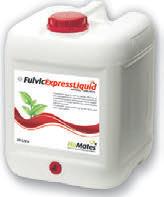


“One of our most widely used products in the organics sector, referred to as ‘the miracle mineral’ is our BioGro certi ed Fulvic Express Liquid.
“It has an extremely high Cation Exchange Capacity of about 1400 which increases the bioactivity and transportation of chelated nutrients and minerals to the plant and allows products such a seaweed and sh to be better utilised in the soil.





“Fulvic is so powerful that one Fulvic molecule is capable of carrying up to 60 or more minerals and trace elements into plant cells. It is also a super food for soil bacteria and fungi.”
Based in Te Puke, New Zealand, Humates is family-owned and operated and is proud to assist its clients in improving soil quality, enhancing yields and nutritional value, while reducing environmental impacts.





Enjoy your favourite paper delivered to your letterbox each month...
www.coastandcountrynews.co.nz - subscribe now








New Zealand’s rst commercial kiwifruit pollen company. While Jill and Graeme remain an integral part of the business, Monica is stepping up from her two-and-ahalf-year role as general manager at Kiwi Pollen.
Having grown up on an organic SunGold orchard, Monica has been inspired by her parents’ ability to raise a family, run businesses, and contribute to the wider kiwifruit industry through governance roles in the Export Institute, BioGro, and COKA.
Eight years’ experience as an in-house lawyer in Wellington and London has given her experiences across a range of industries and organisations. Monica has recently been selected as one of four in Zespri’s Industry Governance Development Programme for 2023.
“I aim to gain a deeper understanding of the kiwifruit industry and the challenges ahead, and subsequently contribute to new initiatives,” says Monica.

“And I am excited to see where new thinking and a fresh approach will lead the pollination business, while maintaining our core ethos of creating value and pro ts for kiwifruit growers.”
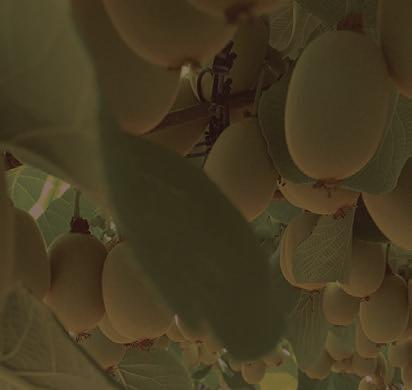

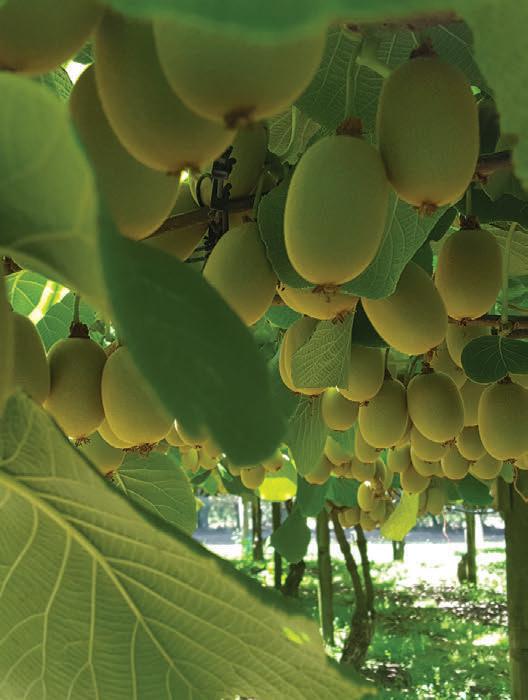
Eating two green kiwifruit a day can improve your sleep quality and mood, and leave you feeling refreshed in the morning, new research shows.
Riddet Institute PhD candidate Alex Kanon and his supervisor, Dr Sharon Henare from Massey University, researched the bene ts of eating two kiwifruit in the evening and found an immediate positive e ect, with participants experiencing a better sleep the same night.
e research was conducted over the past two years.
e Riddet Institute is a Centre of Research Excellence (CoRE), hosted by Massey University in Palmerston North, focusing on advanced food research.
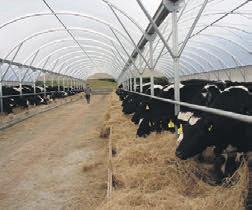
“Other studies have looked at sleep and kiwifruit over a longer period of daily consumption – around four weeks. We wanted to see if we could see an acute e ect – can you eat kiwifruit now and feel the bene ts straightaway,” says Alex.
e research in healthy men (half with poor sleep and half with good sleep) saw participants eating an evening meal, followed by either two fresh green kiwifruit (without skin) or two powdered dried kiwifruit (with skin) or water.

e research team then measured sleep quality, mood and urinary biomarkers.
“We found that regardless of whether you normally have good or bad sleep, kiwifruit had an immediate positive impact on di erent aspects of sleep quality and mood,” says Alex.
Sleep is essential for the cellular repair of the body and can a ect our immune function, psychology and increase the risk of obesity, type 2 diabetes and cardiovascular disease.
One night of sleep disturbance can a ect a person’s ability to concentrate, which may increase technical errors and decrease overall mood the following day. “Both groups felt that it was easier to wake up in the morning and they felt less sleepy after eating the kiwifruit. ere were also improvements in their psychological wellbeing in the morning, with signi cant improvements in positive mood, esteem and vigour.”
“Serotonin plays a central role in the regulation of sleep-wake cycles. We saw signi cant increases in serotonin metabolite the morning after participants ate fresh or dried kiwifruit.”
e research was funded by the High-Value Nutrition National Science Challenge and supported by Zespri International Limited, who contributed fresh Zespri Green Kiwifruit.
MyNameisNeilWoodward.
IamadirectorofZ-Contracting-wearefamilyrun business,ourteamconsistsofthree,beingmyself,my sonandmybrother.
Ourorganisationhasbeenestablishedforover18 years.Ihavebeeninvolvedin applyingcropprotection programmeswithinthehorticultalindustrysince1966.


Wespecialisewithinthekiwifruitindustry, We have theequipmenttosprayorchardswithour two Atomsprayers and one recently purchased Tracatom Formula tractor which is also available for mulching and mowing

MyNameisNeilWoodward
IamadirectorofZ-Contracting-wearefamilyrun business,ourteamconsistsofthree,beingmyself,my sonandmybrother.
Ourorganisationhasbeenestablishedforover18 years.Ihavebeeninvolvedin applyingcropprotection programmeswithinthehorticultalindustrysince1966. Wespecialisewithinthekiwifruitindustry, We have theequipmenttosprayorchardswithour two Atomsprayers and one recently purchased Tracatom Formula tractor which is also available for mulching and mowing
Our Atoms aresetupwithradarspeedsensors,this combined with fullyautomated sprayer controllers and three nozzle ringsenhancesapplicationef ficiency and accuracy.
We also useaquadbikeforstripweedspray applications.

Weholdallcertificatesneededtomeet Globalgap compliance.

Our Atoms combined three nozz accuracy. We also applications.
Weholdallcertificatesneededtomeet compliance.
Welookatallchallengestohelpensureweprotect yourcropwithexcellence.
Welookatallchallengestohelpensureweprotect yourcropwithexcellence. Phone:021907621 E-mail:zcl@zanadu.co.nz
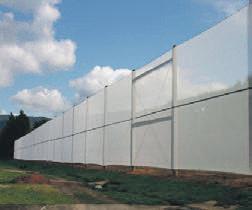



“Please drive to the conditions and expect your journey to take longer.”
at’s the message from Waka Kotahi NZ Transport Agency as the rst day of restored access on State Highway 5 comes to a close.
“It’s been pleasing to see so many road users back on SH5 Napier – Taupō, after the key route was reopened at 7am on March 20,” says
Jaclyn Hankin.“It’s really important to note there’s still a lot of damage on the road, and 32 sites with temporary tra c management in place or temporary speed restrictions, including 30 km/h stretches.” At the time of printing, the road was open 7am and 7pm.
Kiwifruit growers Olivia Manusauloa and Josh Easton of Baygold Limited have taken out Regional Supreme Award at Bay of Plenty Ballance Farm Environment Awards eir kiwifruit development and management company, Baygold, is a great example of a business that is integrating environmental excellence within their kiwifruit production.
In awarding the Supreme Award, the judges noted Olivia and Josh’s guardianship of the land, ensuring its practical use for the future, as well as various initiatives that show real commitment to sustainability.
“ e couple also has a strong focus on providing real and





meaningful support to sta , actively practicing social responsibility within their community,” says an award spokesperson.
Baygold’s orchard, e Station, spans 32ha of rolling Bay of Plenty land, with 16ha of this planted in orchards.
“ e team’s vision is to ensure that development of the business is balanced with caring for the environment.
“ eir approach is based on a cross-business foundation of caring, inspiring, performing and growing.”
A 2.5ha wetland was commissioned and developed before the orchard’s construction began, as a partnership between
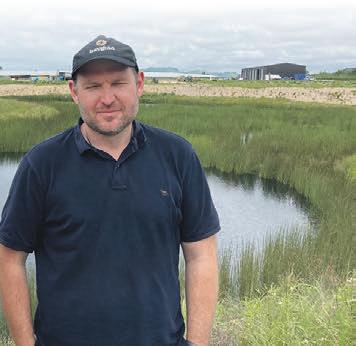
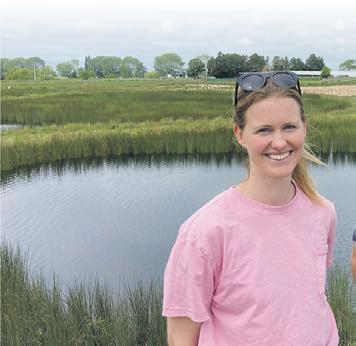
local iwi, council and government.
e wetland feeds into Little Waihi Estuary, slowing and ltering water.
“ e team is now exploring how they can harness the carbon sequestration potential of the indigenous plants.
“Baygold is also one of New Zealand’s rst companies to participate in a carbon zero trial, with an aim of delivering carbon positive kiwifruit to the market.”
Olivia Manusauloa and Josh Easton also won the following awards:
- Bayleys People in Primary Sector Award.
- Hill Laboratories Agri-Science Award.
- Rabobank Agri-Business Management Award.
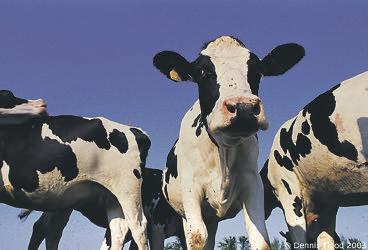







Papamoa horticulture co-owner Lehmber Singh says his fruit are in good shape for the kiwifruit season.

He’s been in the business for 18 years with his wife, Kulwinder Kaur, starting Papamoa Horticulture in about 2005.

It’s kept the name, but their business is now in Te Puke, where the pair have grown to have between 50 to 80 sta depending on the time of season.
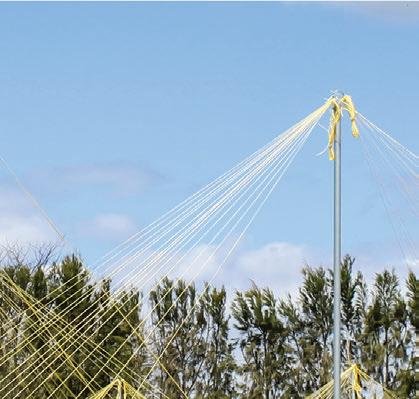
e pair arrived from India, and began their journey in kiwifruit as a way to build a good lifestyle.
Despite having a “hard year” last year, Lehmber says he has hope for the upcoming year of kiwifruit.
“I’m hoping it will be a good season for us. I personally think it will be better than last year.”
e industry is set to take a big hit this year.

Zespri is forecasting nearly a 40 per cent drop in pro ts, driven by “quality costs” with New Zealand supply, and a reduction in “non-New Zealand” supply volumes.
is information comes from Zespri chairman

Bruce Cameron. He says last year the company earned $361.5 million after tax, and the forecast range for this year is $217 to $227 million, representing a 37 to 40 per cent drop.
Even though New Zealand’s kiwifruit marketer is forecasting a tough year, Lehmber remains hopeful for the future. “I hope the industry as a whole bounces back in the next year. But a lot of work will have to be done, as there was a lot of fruit loss last year.


“A lot of it will heavily depend on the harvest season which is starting soon.”
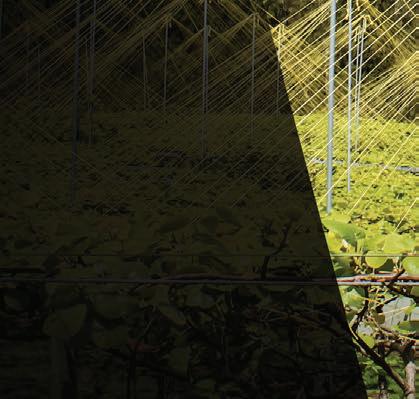































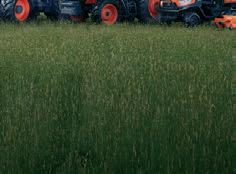


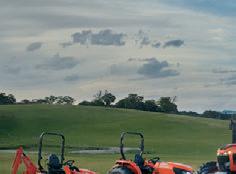
Zespri’s board has con rmed their intention to list the company on New Zealand’s stock exchange, NZX, late this year. “An NZX listing is an important prerequisite to be able to implement initiatives designed to help unshared and ‘under-shared’ growers become shareholders,” says Bruce.
Lehmber says Zespri’s intention to list the company is “a good sign” for the future of the industry.
“When they list it, it means other people can invest more easily. If they want to attract more investors, it’s always a good sign for the industry.”
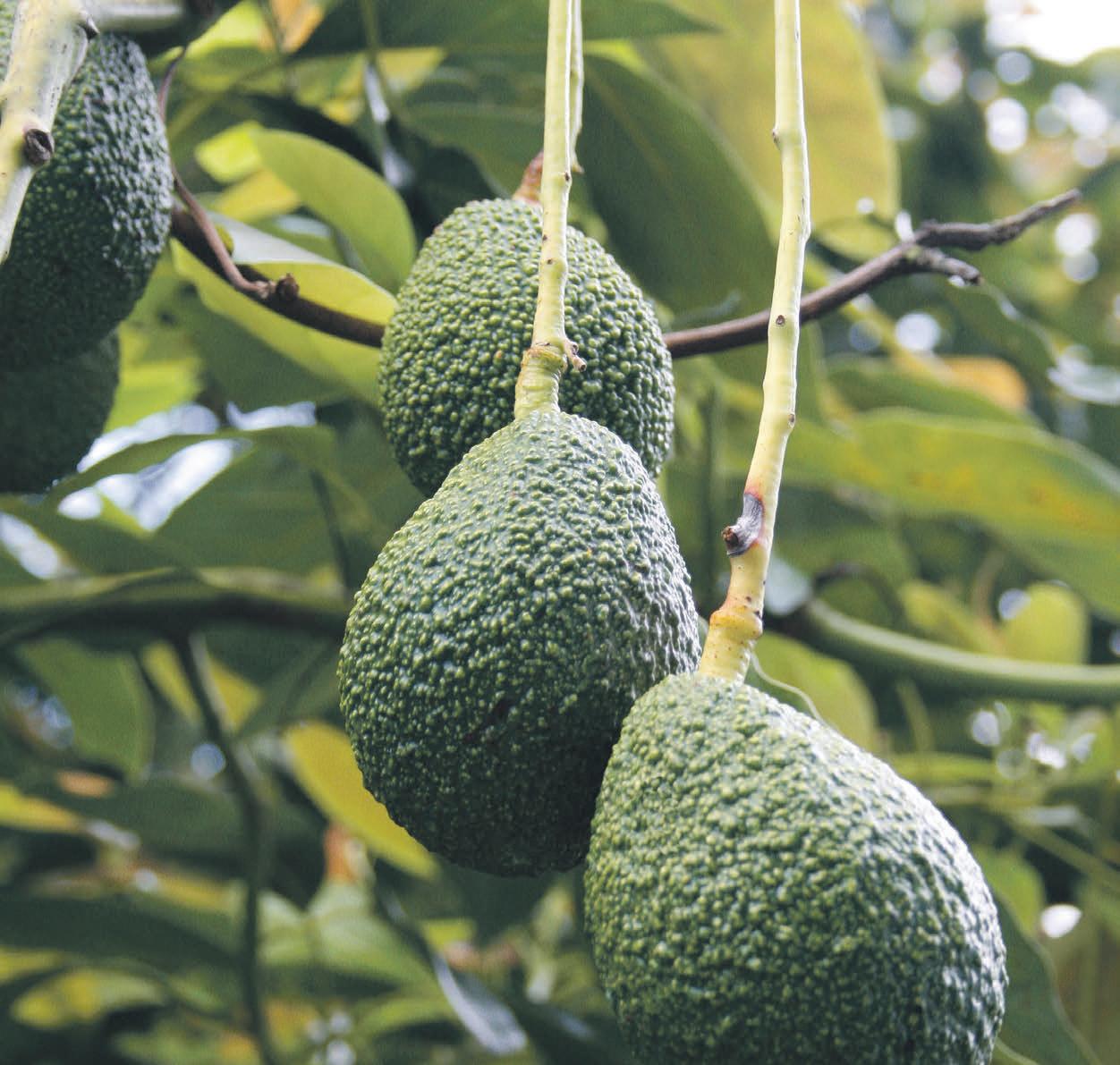


Looking to expand your orchard’s development potential? Seeking extra support? Or are you looking to step back from daily operations and have more free time?
Seeka’s Orchard Management Services can help drive your orchard forward, deliver you more free time and provide you with the con dence that your orchard is compliant.
O ering a tailor-made Orchard
Management Service to suit your growing requirements, Seeka’s expert team can support your orchard development interests.
Services range from full management of daily operations to more singular functions, full labour supply to the set-up and establishment of new orchards.
Growers utilising Seeka’s Orchard Management Services are provided with an Orchard Manager and a Client Relationship Manager, both of whom
will work with you year-round to plan and perform key orchard operations and manage your best interests, helping you to achieve your goals and the best possible returns.
A dedicated Orchard Manager will work alongside you to develop a detailed Management Plan, built around your speci c needs, and a working budget to ensure your property reaches its full potential. Regular meetings plus budget reports will keep you fully informed and in control of your investment.
By having your orchard managed with Seeka you will be able to access

• Seeka’s labour force
• Custom performance-built reporting
• Full crop management system
• Reporting and forecasting systems

• Full compliance management


• On-call technical support
Seeka has been helping more growers deliver more produce to more markets. All growers receive the cost saving of a larger-scale business while the company remains rmly committed to ful lling each grower’s individual needs.
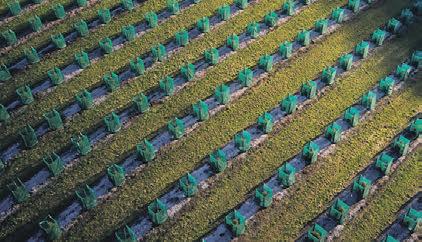
In 2016, to complement Seeka’s very successful Hass avocado marketing programme, Seeka was awarded the exclusive rights to market all New Zealand-grown GEM avocado.


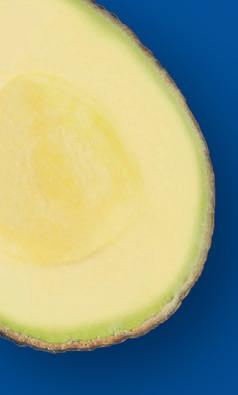

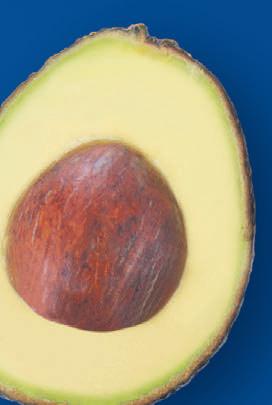




If you want the certainty of skilled labour – you’ll nd it with Seeka.

Given its highly-skilled labour force, it’s no surprise that Seeka values education. Seeka proudly runs a three-year cadetship programme that delivers on-thejob training for young people interested in Orchard or Packhouse Management.
Seeka’s Post-harvest Teams use the latest packhouse and cool chain technology to minimise costs and maximise returns for orchard produce.
Seeka handles its avocados and other produce on purpose-built machines that accurately detect the grade of produce and any defects. is, along with additional phytosanitary steps, such as residue testing and preharvest monitoring, ensures better-quality fruit is delivered to market.
Seeka is committed to applying industry best practices for land management, using the latest technologies to deliver healthy produce to our clients and consumers.
In a bid to reduce organic waste generated in Seeka’s postharvest facilities, they sourced four commercial sized continuous ow vermicomposting systems (worm farms). Capable of processing up to 100 tons of organic waste per year and housing around 50,000 worms, this circular process is helping Seeka to close the loop on waste, with the harvested vermicompost being utilised as a soil conditioner for Seeka’s citrus and avocado plants.
Seeka has installed 446kW of solar panels on its postharvest facility rooftops, with more solar installations planned with a target to reach 1000kW installed by 2025.
Continually improving its waste management strategy Seeka recycles all waste cardboard back to its packaging supplier.
More recently Seeka’s New Zealand-based wholesale market and distribution services, SeekaFresh, partnered with Perfectly Imperfect, utilising their connections at DryNZ and Island Gelato Company, to save over half a tonne of cherries deemed both export and local market rejects, redistributing them to market as a new avour of gelato.
Contact the team today at info@seeka.co.nz
Otama Marere orchard.Avocados are an important high-value horticultural crop in New Zealand.
ey are our third largest fresh fruit export earner, behind kiwifruit and apples. e market is growing and the industry is actively investing in growth.
ere are around 4000 hectares of avocado orchards in New Zealand, reports Tupu.nz
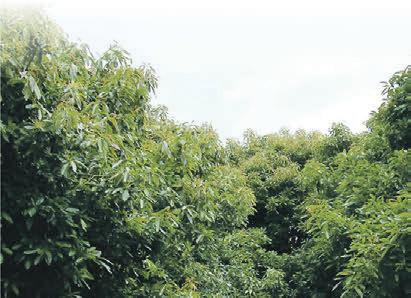
Around 85 per cent are in the Bay of Plenty and Northland areas. Hass is the most widely planted variety in New Zealand and is currently the only variety that can be exported.

Returns for well-run orchards are high, but avocados require skilled management to maintain healthy trees and a reliable crop.
Without this expertise it’s di cult to make a pro t, so it’s important to seek advice and support.
Just over 50 per cent of New Zealand avocados are exported and




40 per cent sold in the domestic market. Processed product makes up the rest.
Australia takes about 80 per cent of the export crop, with the rest sold throughout Southeast Asia, particularly Korea.
In 2018 the rst exports to China began, opening a large market which has excellent growth potential.
e domestic market for avocado is strong, with the average New Zealander eating 2.2 kg (about 12 fruits) a year.
Avocados are not imported into New Zealand — all avocados in the shops have been grown locally
In 2018 the industry set down a strategy to triple productivity and quadruple returns per hectare by 2023, supported by a government-funded Primary Growth Partnership scheme. Research has focussed on:
- assessment of new cultivars and rootstocks that increase production, improve pest and

disease resistance and improve the range of soils and climates that can support the crop
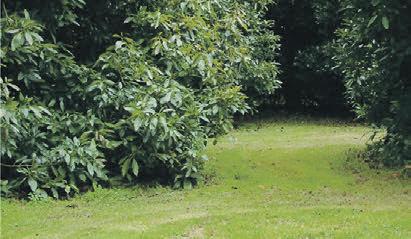
- opening up new export markets and growing existing markets, and



- production systems to increase
yields and reduce costs. Sector challenges include:
- biosecurity
- dependence on the Australian market
- accessing skilled labour
- getting more consistent yields,

- improving fruit consistency and quality throughout the supply chain, and


- informing consumers on how to handle, store and use avocados.
Sourced from www.tupu.nz



In the 1950s, the avocado was known unsentimentally as the crocodile pear because of its hard, wrinkled skin, but over the years it has also been known as the custard apple, the butter pear and the vegetable pear.
Either way, in New Zealand, we love them. Whether it be smashed on our toast, as a dip, in our salads, and even as a facial moisturiser. As a bonus, they’re good for you!
Avocados contain a wide range of nutrients and various health bene ts, boasting improved digestion, lowering the risk of depression, preventing bone loss, supporting heart health, protecting against cancer, and more!
New Zealand currently produces just two per cent of the global supply but is the ninth largest international avocado exporter.
Nearly 5000 hectares of avocado trees are currently planted in New Zealand, primarily in the




Bay of Plenty and Northland.* ese facts, paired with the primary-aged children selling avocados from their driveways, may lull you into believing we have an abundance of avocados, but you may not have noticed the roller coaster of daily life that orchardists have faced in recent years.
Cyclone Gabrielle was unprecedented, and many growers are still reeling from the devastation it caused, but throw in climate change, Covid-19, and labour
shortages and it’s becoming increasingly more di cult to grow avocados and satisfy consumer demand! Before you panic-buy all of the avocados though, know that there are numerous behind-the-scenes experts doing all they can to ensure we have supply.
e Technical and Grower Services Teams at Trevelyan’s are a talented group of avocado specialists that boasts numerous agricultural degrees and vast hands-on experience in the industry (one of the team was Bay of Plenty’s Young Grower of the Year, 2022).

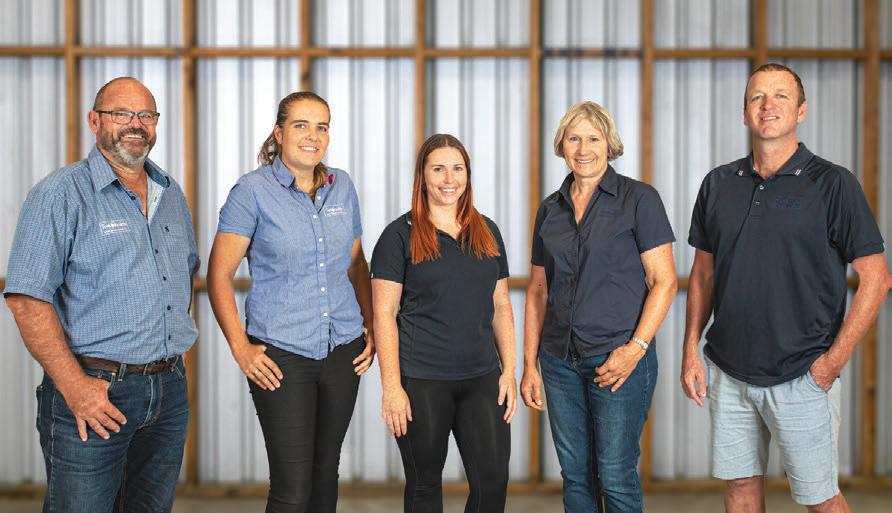
eir passion is simple - they want to help their growers succeed.
is is a team that works tirelessly on orchards and in the lab, discussing theories and research with other industry leaders and regularly visiting each of their growers. eir support and guidance is shared by way of numerous educational workshops, discussion groups, avocado improvement seminars, weekly technical tips and deep-dive analyses.
From that initial handshake greeting on the orchard, the working relationships between Trevelyan’s representatives and growers is built on great communication and deep respect.
Trevelyan’s head of avocados, Dan Birnie, and avocado technical manager, Dr Jonathan Cutting, are constantly researching, experimenting, and challenging each other and their team, to think outside the box.
No two orchards are the same, but with the team’s breadth and depth of knowledge, and their innovative ideas, they always nd a best- t solution.
Dan believes it all bubbles down to one word‘connection’.
“We want our growers to feel connected to the Trevelyan’s team and see us as an extension of their business, we run events across New Zealand because we want them to connect with other growers and build their local knowledge, we also want them to feel connected to their land, so that they can cultivate high-quality fruit. If you have a good connection, you have trust.”
Jonathan has a real focus on regenerative orchard principles, it’s about understanding and working with nature. His advice is simple. “ e next few years can provide growers with increased pro tability, as long as we embrace new approaches, technologies and production systems and adapt to what nature can sometimes throw at us.”
Jonathan has also been driving the movement to high-density planting. In short, he is closely working with about 30 growers to use smaller trees per hectare so that quality issues can be tackled quickly, production costs are dramatically reduced, fruit to market is increased and growers’ nancial positions are improved.
New Zealanders care about where their food comes from, where it was grown, and what methods were used. So, the next time you see avocados in the supermarket, or you’re considering an avocado delivery subscription like BayFarms, or you’re buying avocados from children selling them from their driveways, take a moment to remember the connected group of people nurturing its growth through unprecedented challenges.
Living without the delights of smashed avocado and guacamole would be such a lesser experience for us all. anks team.
Source - https://industry.nzavocado.co.nz/about-us/
Dan Birnie -“We want our growers to feel connected to the Trevelyan’s team and see us as an extension of their business”. -As Matt Royackers re ects on his past year as a Grower Services Representative at KauriPak, he knows he made the change for the better.
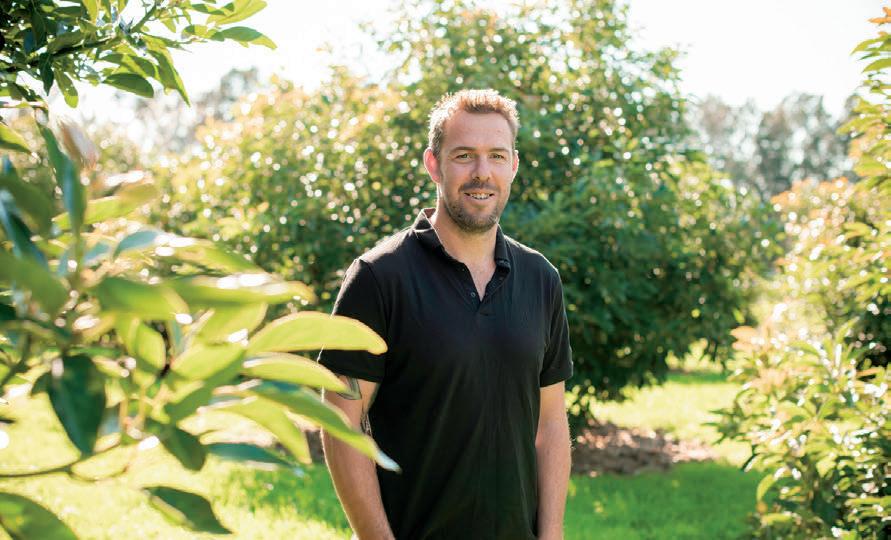
“It’s de nitely a change of pace from being on the ladders that’s for sure,” says Matt.
Matt started working for Aongatete Avocados Limited 15 years ago when he was given the opportunity to complete his horticulture cadetship whilst working.
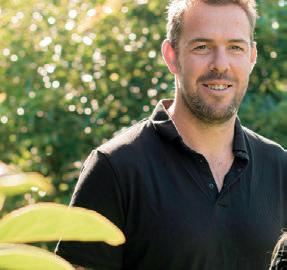
He then moved into the family avocado contracting business, Roys Avos where he stayed on for 12 years.



When the opportunity came up for a Grower Services Representative role at KauriPak,

he applied for the role with his family’s support.
“Having been out in the orchard for a number of years I was keen to try something new, that was a little less weather dependent,” says Matt.
With three young kids, his new role has o ered him a better work-life balance allowing him to help with the family’s busy schedule of dance, gymnastics, karate, football and more.
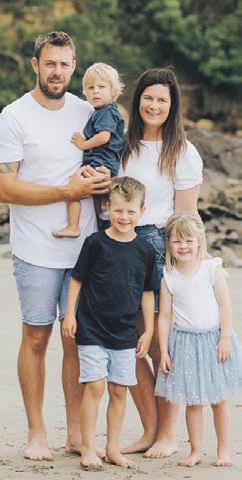
Invaluable addition
KauriPak Grower services manager Aimee Barker-Gilbert says Matt has been a great addition to the team.
“His experience working on orchard is proving invaluable and you can see that his growers respect what he has to say.”
“It’s hard not to jump on a ladder and do some of the work myself sometimes,” laughs Matt.


e Bay of Plenty is arguably the home of avocados in New Zealand.
ose avocados have been on a world stage earlier this month at the World Avocado Congress, which was hosted in New Zealand for the rst time ever.
With Katikati being the avocado capital of New Zealand and with the region’s (typically) warm climate and fertile soil, the BOP is renowned for producing delicious avocados, says Jen Scoular, current Chair of the World Avocado Congress Committee and CEO of New Zealand Avocado, based in Tauranga.
“ e World Avocado Congress was such a ripe opportunity to have our incredible avocados more than world famous in New Zealand. e congress will showcase New Zealand avocados on the world produce stage and also promote the New Zealand experience. e world really is our oyster, or perhaps I should say ‘the world is our avocado!’.”
e World Avocado Congress was the largest ever global delegation to come to New Zealand for a horticultural event with more than 1100 people representing 32 countries.
More than 700 of the delegates came from outside New Zealand, and many travelled to New Zealand for the rst time.
“ ese numbers have exceeded all our expectations. We were so excited to host such a large contingent of the global avocado community, including international and national growers, researchers, marketers, retailers, tech innovators, investors and more. is week we have released the congress programme so things are getting real!”
e World Avocado Congress took place on April 2-5 and covered a diverse range of nationally and globally relevant topics across the entire avocado value chain, including the future of food, sustainability, climate change, food trends, food security, global supply chains and the lifecycle for avocado production.
e congress was comprised of a three day academic programme with eight international and national keynote speakers and more than 130 presentations.
“A considerable part of New Zealand’s primary production sector has been impacted by recent weather events so we all need to hear experts talk about the future of food, climate change and the global impacts on horticulture right now.

“It’s been a tough few years for our growers and the whole industry has faced ongoing challenges with the supply chain.”
Field days on the agenda
While the Bay is New Zealand’s home of avocados, given the size and scale of the event, the congress took place in Auckland.
Before the congress began, delegates had the opportunity to attend eld days in the Bay of Plenty, Northland and South Auckland where they experienced the diversity of avocado growing systems and supply chain processes in NZ.
New Zealand was one of three countries to put forward a bid to win the hosting rights for the 2023 event and was up against Mexico, the largest avocado exporter in the world, and Kenya, the sixth largest exporter of avocados globally.

With the World Avocado Congress only a few days away he is very grateful that he will get to opportunity
to attend for work and be able to network with other avocado enthusiasts from around the world.
You don’t know what you don’t know –BUT YOU CAN!
Soil classification gives you the “blueprint” and potential of your farm. This is invaluable for existing orchards and new developments.
Giving you insight for better crops by:

• Identify and assess root health and irrigation efficacy

• Allocate ideal soil moisture probe placement
• Recommend intervention strategy for suboptimal performing areas
• Identify areas that require drainage (directly linked to plant health)


• Recommend cultivation techniques to alleviate potential root limiting issues
• Identify leaching zones so you can manage them
Add precision Agriculture by:












•
•
•
for nutrient insights
to manage soil health
to treat areas where needed
Know your soil’s status, contact your nearest Agri Technovation specialist at - 09 954 5411

Agri Technovation – The precision farming people. (See you at WAC 2-5 April Auckland)





Not particularly noticeable, but the rst change of season for the new year has greeted us, as avocado growers start to turn their attention away from harvest operations and towards orchard management and tree health.



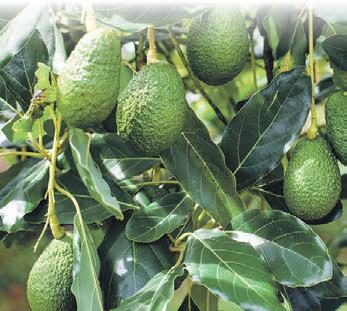
Up until the end of summer, which was on February 28, Katikati has recorded 1329mm of rain since the start of September.
In comparison, for the same period last year Katikati had 604mm.
e six-month period saw a wet pollination period and a disrupted export harvest schedule, a ecting all in the industry more than initially thought.
Concluding harvest operations, orchard owners are counting their coins; those who have late crops will reap the bene ts of an exaggerated price, while others will be focusing on optimising productivity for another
year. With the accumulated rainfall we have experienced, high on the priority list should be injecting; a tree trunk injection treatment method that is precise, highly e ective and a practical method for controlling Phytophthora root rot in avocado trees.




Avocado trees are highly susceptible to Phytophthora root rot, a disease caused by the soil-borne pathogen Phytophthora cinnamomi. e

pathogen is known to survive for many years in moist soil, and it is evident that moisture is a key factor in the establishment, spread and longevity of phytophthora. Additionally, disease development is enhanced after heavy rain and in waterlogged soils. Once a tree is infected, the disease can cause extensive damage to the root system, leading to reduced uptake of water and nutrients, and a weakened tree that is more susceptible to other diseases and pests. is can result in reduced yield, poor fruit quality, and even tree death.
e most e ective way to control Phytophthora root rot in avocado orchards is with tree trunk injection treatments. Tree trunk injection delivers solution directly into a tree’s vascular system, ensuring that the substance reaches the intended target quickly and accurately. is method also minimises the risk of drift or run-o , particularly important for growers who are committed to environmentally sustainable practices and wish to avoid the use of broad-spectrum fungicides.
Research has shown that tree trunk injection, using AvoJect syringes, with fungicides such as HiPK (a phosphorous acid) can provide longlasting protection against Phytophthora root rot in avocado trees. e fungicide is translocated throughout the tree, including to the roots, where it can provide ongoing protection against the Phytophthora cinnamomi pathogen.
Trunk injection treatments are easy to apply and can be done by growers themselves using AvoJect syringes. is makes them a cost-e ective and practical option for growers, particularly those with smaller orchards or on restricted budgets.



Given the substantial rainfall New Zealand avocado regions have experienced in the past six months, growers need to take proactive measures to protect their trees against Phytophthora. Phytophthora is a serious threat to New Zealand avocado orchards. By injecting trees with fungicides such as HiPK, growers can provide ongoing protection against the pathogen, leading to increased yields, improved fruit quality, and a more sustainable avocado industry in New Zealand.
 AvoJect syringes being used to inject HiPK into avocado trees for prevention of Phytophthora root rot.
Photo: Katie Cox Photography.
AvoJect syringes being used to inject HiPK into avocado trees for prevention of Phytophthora root rot.
Photo: Katie Cox Photography.

Darling Group’s aim to develop long-term markets in Asia for their New Zealand avocado volumes, produced by Just Avocados growers, is coming into laser focus for the 2023-2024 season.
Darling Group signalled last month there are new norms that avocado growers need to understand and incorporate into their decision making.
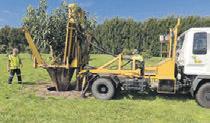
“New Zealand has historically relied on Australia as the primary export market but as production increases over the ditch, there are less growth opportunities for New Zealand avocados,” says sales and marketing manager Shaun Mckone.
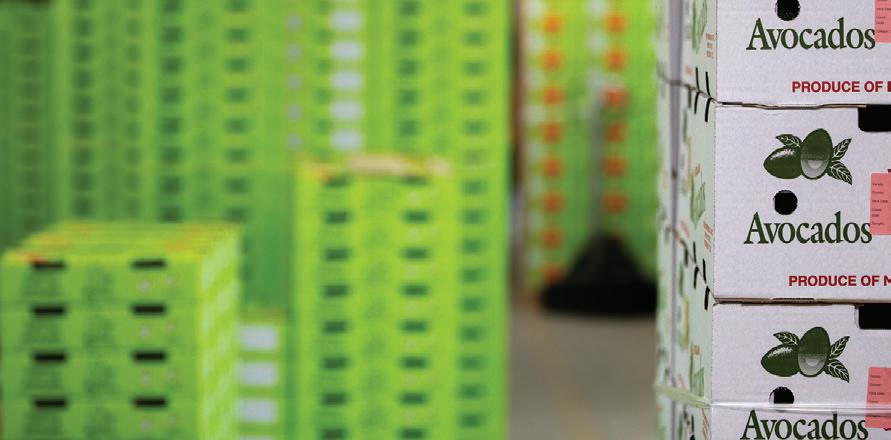
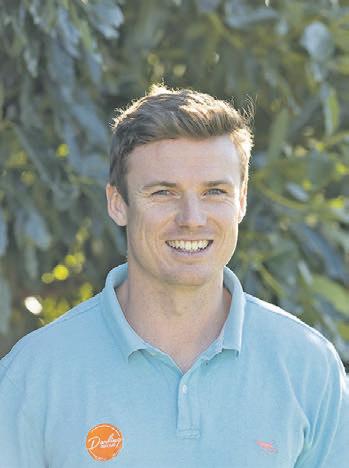
Growth in production in New Zealand has also driven the need to explore other markets – and Asia has been the logical target for the industry given the geographic proximity.
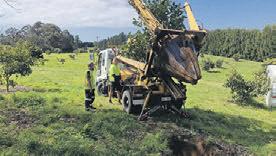
Darling Group’s commitment to Asia being the dominant export destination for New Zealand avocados long-term is apparent in their 12-month supply strategy, says Shaun.
“Darling Group’s 12-month supply strategy is designed to maintain engagement with customers in Asia all-year-round as opposed to being in the market for the New Zealand season and then out again for eight months.”



To achieve this, Shaun says Darling Group sources fruit from growers in Peru, Mexico, and California to ll supply when New Zealand avocados are out of season.
“ e 12-month supply strategy continues to develop across markets in Asia and we are beginning to see positive outcomes.”


While Darling Group has been exporting New Zealand avocados to China since access to the market was gained in 2018, their goal is to have more control over the channels to this market.
eir aim to gain relevance in China has gained



Varieties of avocado are harvested in New Zealand at di erent times of the year making them available all year round.
Varieties grown in NZ include Hass, Reed, Fuerte and Carmen.
Hass avocados are oval in shape with skin that darkens as it ripens and are available August to May.


Reed avocados are large and round, their skin stays green when it ripens and they are available February to June,

reports 5+ A Day.

Fuerte avocados are pear shaped, with thin matte green skin that stays green when it ripens, they are available July to October.
Carmen avocados can produce two lots of fruit: one in spring and one in autumn:
- e Spring-set Carmen look identical to the Hass variety with the same skin characteristics.
- e Autumn-set Carmen is larger, rounded and has a smoother skin than the Hass fruit – this skin also darkens as it ripens.
5+ A Day recommends people ripen avocados at room temperature then store in the refrigerator.

“Avoid squeezing avocados as they bruise easily,” says a post on the charity’s website.


“Choose Hass avocados based on colour – bright green are not ripe, olive green will be ripe in two to three days, brown green are rm ripe and purple brown are soft ripe.
“Handle all produce with care and wash well before eating.”
support from New Zealand Trade and Enterprise, which is co-investing with them in a project to investigate the opportunity for Darling Group to build a brand there.
“ e work with NZTE is exciting – by the end of the year we will have validated our strategic approach to China. e next step from 2024 will be implementing the go-to-market
strategy,” says Shaun. “NZTE’s co-investment and ongoing support from their sta in-market and access to specialists has enabled us to accelerate our international growth aspirations.” Darling Group has also included Hong Kong in the project as this market, along with China, was de ned through a research project and internal evaluation as Darling Group’s tier 1 markets.
Saving our Trees
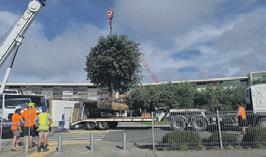 Darling Group’ sales and marketing manager Shaun Mckone.
TREE TRANSPLANT SERVICES
Darling Group’ sales and marketing manager Shaun Mckone.
TREE TRANSPLANT SERVICES

Calcium is not a cure-all for avocado problems, but prudent, informed applications can improve the health and productivity of an avocado orchard, says Leighton Whit eld of Winstone Gypsum.
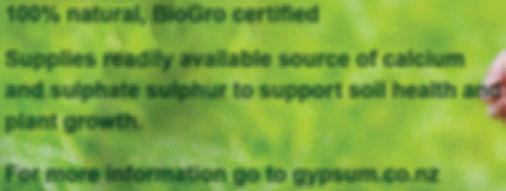



“Among other forms of calcium, Gypsum is often used to increase soil permeability, loosen clay soils, develop soil structure, and remove exchangeable sodium from the subsoil. “Calcium carbonate (limestone) is frequently applied to raise the pH of acidic soil.”
Leighton says maintenance of calcium supply is essential for plant growth. “In avocado orchards, calcium governs cell wall strength and is used at the rapid fruit cell division stage of fruit development.
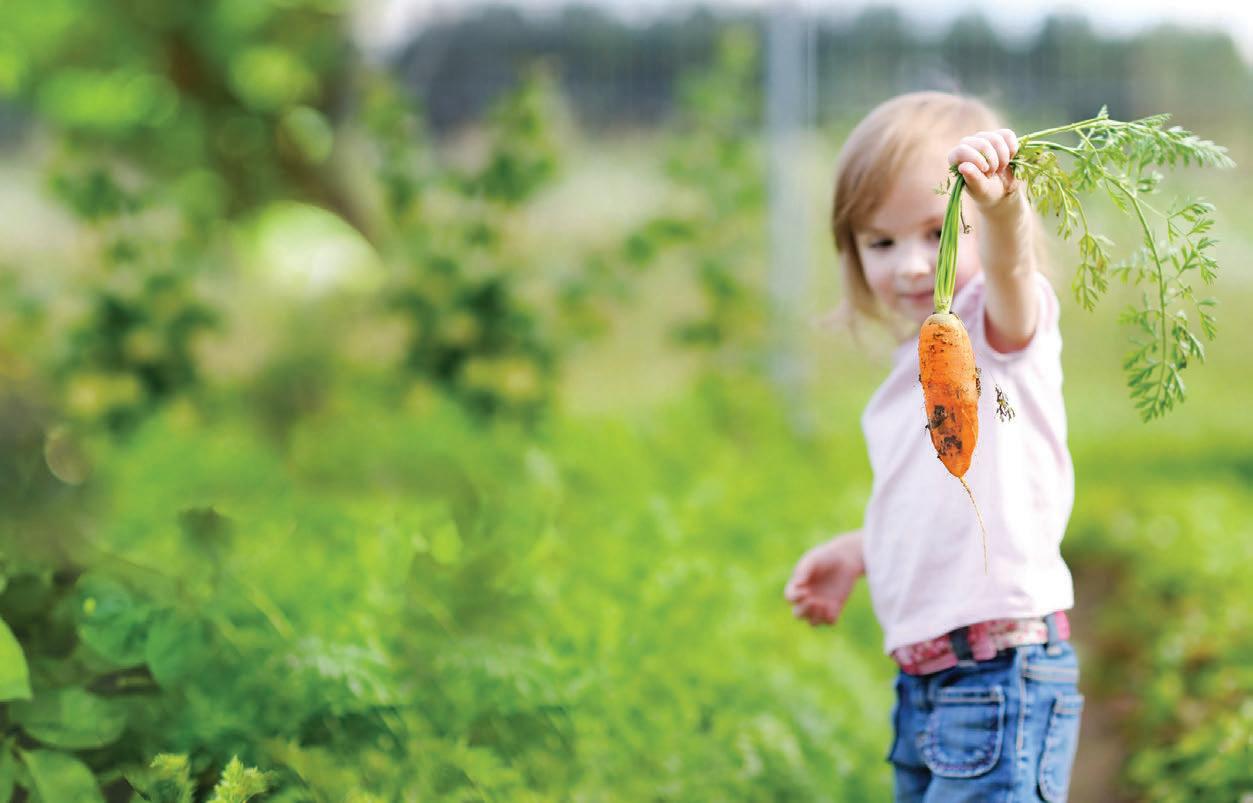

“Su cient calcium levels also a ect avocado fruit yield, size, and postharvest quality. High internal levels of calcium slow the ripening of the fruit, and
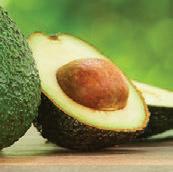




For more information go to gypsum.co.nz
cold-induced disorders are decreased.”
A Californian study of avocado orchards found the calcium in gypsum can create favourable conditions in the soil for the tree roots to do well.

“Soils suppressive to avocado root rot were found to have high levels of organic matter, high levels of available calcium, available nitrogen, and high microbial activity.”


Leighton says NZ Soils are de cient in sulphur – and gypsum is one way to boost overall sulphur levels. “Aim to have luxury levels during active periods of crop growth to support plant processes and photosynthesis.”
Gypsum works well when incorporated into a long-term programme as an available source of calcium and sulphur, which can be applied on its own or alongside other fertiliser applications. Talk to your advisor for further information and guidance on applications of gypsum in your orchard.
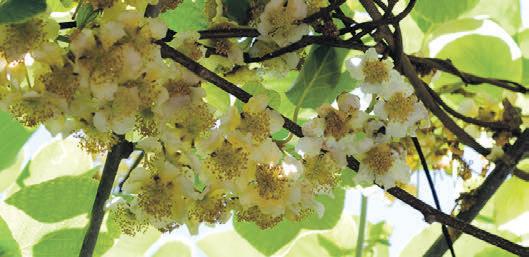
soil.
100% natural, BioGro certified Supplies readily available source of calcium and sulphate sulphur to support soil health and plant growth.
six day tour, nights for the seven day tour are Hanmer Springs, Methven, Geraldine, Twizel, Omarama, Cromwell and Cardrona.”

Accommodation provided is hotel/motel and for the most part, evening meals and breakfasts are in restaurants on site. Lunches are a mixture of station and picnic.
“Highlights of the tour will include Molesworth Station on the afternoon of day one and the vast hill country of North Canterbury through most of day two.
“Day three sees the tour heads west towards the high alps and the massive vistas of the inland valleys, on the seven day tour we will nish a little earlier than usual and overnight in Geraldine. Day four takes the tour
across the high plains and gravel river valleys of the Mackenzie country along with some hill country tracks with views back to Mt. Cook.
“Days ve and six see the tour drive over into Central Otago and the opportunity to drive very high onto two of the mountain ranges that are so much a part of this region known for its history of gold and pastoralism and for being as far from the sea as it is possible to get in New Zealand.
“In the context of a 4WD Tour the tracks are easily enough travelled by competent drivers in suitable four wheel drive vehicles (low range transmission) and all terrain (AT) tyres in very good condition.” For more information, see NZ Adventures’ advert on this page.

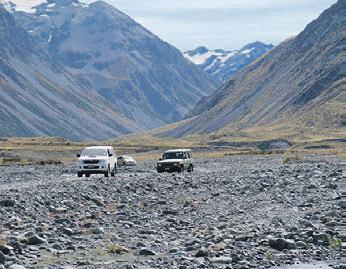
NZ Adventures is o ering the High Country Heritage Tour as a six Day Tour in February, April and November and as a seven Day Tour in March next year.

e March Tour will nish at Cardrona on March 28, 2024.
It’s a good opportunity to come down and enjoy “Warbirds over Wanaka” which starts on
Good Friday, March 29, says a NZ Adventures spokesperson.
“

e High Country Heritage is essentially the journey down the eastern alpine foothills from Blenheim to Cardrona.
“ e tour includes a wide range of high country stations and conservation estate tracks along a 1250km route enjoying overnights in Hanmer Springs, Methven, Fairlie, Omarama, Cromwell and the last night at the Cardrona Hotel for the



United Fresh New Zealand is advising consumers to be prepared for fresh vegetable shortages in the coming weeks as oodwaters throughout the upper North Island impact food safety.
United Fresh food safety representative Anne-Marie Arts says excess rainfall will a ect the quality and shelf life of many crops.
“Flooding exposes fresh produce to microbial risk. If oodwaters come in contact with the edible part of the crop, it is considered to be contaminated and will not be harvested,” she says.
“After the ooding subsides, growers will not harvest the a ected crops and will have special protocols for disposing the a ected plant matter. Replanting the land will not occur for some time until it is dry and considered suitable. ese delays might result in supply gaps of some varieties.”
Crops that might be suitable to pick will now be quarantined until they are declared safe to eat by microbial testing.


Anne-Marie notes that those with home gardens must take the same precautions.

“Whether it’s a commercial farm or a home vegetable garden, oodwaters present a real risk to the health of your whanau.

“Floodwaters can ush through sewer systems and across rural land collecting human and animal waste. e waters may contain pathogens that can make you seriously ill.


“We’re advising anyone with a home garden that may have had oodwater enter to throw away a ected plants immediately.






e severe weather event comes on top of a summer of rainy conditions which have already impacted the supply and price of fresh vegetables nationwide.
“Growers follow strict protocols to ensure the kai they provide is safe to eat. While this ood has worsened our supply situation, the whole industry will be working hard to get enough fresh vegetables to market in the coming months.”
Further information about food safety in an emergency can be found here:
For growers: fpsc-anz.com/2022/03/09/resources-onoods-and-food-safety-2022/


For markets, retailers and consumers: www.mpi.govt. nz/funding-rural-support/adverse-events/food-safetyin-natural-disasters-and-emergencies

Building was something Simon and Sarah Cowan never contemplated.
ey scoured Cambridge for more than a year looking for a home that ticked all the right boxes, but to no avail.
Rather than wait another 12 months hunting for that “unicorn” property, the couple decided to build their own dream home. ey then turn to Landmark Homes for help.


“It ended up being a lot more cost-e ective than trying to buy and renovate – and we got exactly what we wanted from our home,” the pair say.
Like many families, they had a dollar amount in mind that they wanted to spend on the build.
Research
“I did a lot of research into the di erent building di erent companies,” says Simon.



“What we liked about Landmark from the get-go was the quality. Landmark were o ering the highest-quality nish from the builders we looked at – and had the biggest house plans at our price point.”
With budget top-of-mind, the Cowans chose to use a ‘Ready to Build’ plan.


“Doing so o ered price certainty,” says Simon.










It was the Tekapo plan’s size and aesthetic that caught their eye.
To suit their needs and tastes, the Cowans made changes to the oor plan and design - exactly the type
of challenge the Landmark Homes design team relishes.


“Landmark gave us freedom to alter the plan to suit us and nothing was ever a problem. As the homeowner, it made us feel that we weren’t getting something cookiecutter. Yes, we chose their Ready to Build plan, but they allowed us to make it ours and individual.”
Some of those changes included opening up the lounge, dining and family rooms into one big openplan space to create a fantastic ow through the house.

e 3.5m high double doorway Landmark worked with a local joinery company to install in the entrance.
“It’s so striking, and really does the big entranceway justice.
“All the modi cations we made to the plan were done with the budget in mind, I was grateful for Landmark – they had a very comprehensive price list, and if you wanted to upgrade anything, it wasn’t an issue or a hassle to do so.”
When it came time to build, Landmark took care of all the consents – which was fantastic for the couple who were living in the South Island at the start of the project. And once they had moved north, they loved going to see the tidy, well-kept site.

A big stand-out was the open communication, which was very reassuring for these rst-time builders. “ e beauty of Landmark is that they supply a Project Manager,” says Simon.
any issues onsite, or want to make any changes, it’s just the case of a quick phone call.

“We were in constant contact with our Project Manager who would stay in touch with us to update us on how things were going. We never felt we couldn’t ring them, or it was uncomfortable to call – the easy access to them was great.”
Having been in their home for several years now, the family couldn’t be happier.



e ve-bedroom home features a host of windows and wonderful indoor-outdoor ow, to let the light spill in and to soak up the countryside views – and an outside space for relaxing, entertaining, or keeping an eagle eye on the kids in the pool.
“When it’s warm and sunny you can open the big bi-fold doors, and really open the house up to the outdoors. We’ve got two covered porticos on a concrete heated patio, and we love sitting under there all through the day, whether for a morning co ee or an afternoon wine.”
Meanwhile, Sarah is over the moon her dream kitchen has come to life, complete with a classic English villa butler sink. So, would they build again with Landmark Homes?
“Absolutely! I wouldn’t hesitate to build with Landmark Homes again or recommend them. We’re very happy with the home we’ve got… and my wife is incredibly house
























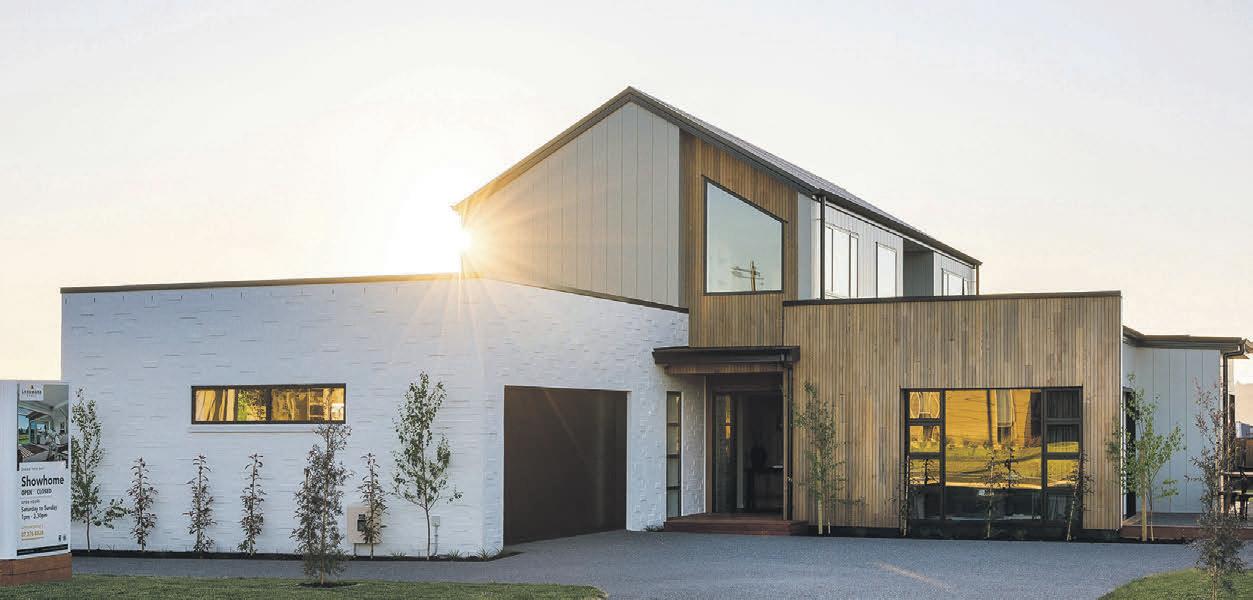







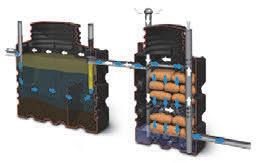
BEST BUY!
$82.95 for 2 bottles post-free or 1 bottle $43.95 plus $5.99 postage Each bottle has 120 capsules, approx 2 months’ supply per bottle.
TREATMENT
TREATMENT

What is Magnesium Triple?
This is a blend of 3 highly bioavailable forms of Magnesium for rapid absorption and better results.
•Marine Magnesium 121 mg
•Magnesium Glycinate 240 mg
•Magnesium Citrate 258 mg
How can Magnesium Triple help?
•These high grade forms of Magnesium are quickly absorbed to et rapid ene ts


•It is ideal to help relax sore or tight muscles
•Can help with restful sleep
•To help with PMS related tension
•Helps muscles recover after exercise
•Supports healthy heart rhythm
John Arts comments:
“Abundant Health rapid absorption Magnesium Triple can really help tight or stressed muscles and for a good night’s sleep. The 3 different forms of Magnesium mean you get fast results. The normal dose is 2 before bed.” (John Arts, Founder, Abundant Health Ltd)
Or order online at www.abundant.co.nz
Abundant Health Ltd, PO Box 8348, Cherrywood 3145


e women’s health study is one of the most in uential medical studies.
is followed nearly 30,000 female health professionals who are over 45. It is still going now after 30 years.
One of the many observations was the relationship between magnesium and hypertension (high blood pressure).

e study showed magnesium intake was inversely related to hypertension; that those with low magnesium had much higher chances of developing hypertension. Indeed, it seems as if magnesium can help many conditions including cramp, heart rhythm, mood, sleeping any many more. is should not surprise because of the special role of magnesium in governing muscles and nerves. Calcium is the mineral that causes muscles to work and nerves to carry impulses. Magnesium helps
return muscles and nerves to a resting state. How does magnesium help hypertension? Our blood vessels have a special type of muscle called smooth muscle. Just as magnesium de ciency can cause cramp or tightness in our skeletal muscles, so low magnesium causes smooth muscle to lose its natural suppleness. is can impede blood ow and forces the heart to pump harder to circulate blood. e main mechanism is that magnesium is a powerful calcium channel blocker (many hypertension medications are calcium channel blockers). is allows the smooth muscle
in blood vessels to relax thus allowing for enhanced blood ow. e challenge is to get the right forms of magnesium in the right doses. My preference is to use three di erent forms of magnesium: natural marine magnesium from sea water, well proven magnesium citrate and probably the most e ective, magnesium glycinate. We then need to get the right doses. is is where one-a-day supplements can be di cult as you cannot modify the dose. My magnesium has a dosage range of one to four capsules so can be customised to a person’s needs.
John Arts (B.Soc.Sci, Dip Tch, Adv.Dip.Nut. Med) is a nutritional medicine practitioner and founder of Abundant Health Ltd. For questions or advice contact John on 0800 423559 or email john@abundant.co.nz Join his newsletter at www.abundant.co.nz





Recent weather events have raised food security concerns for parts of New Zealand’s primary-production sectors.
Leading environmental scientist Dr Brent Clothier says a signi cant shift in focus is required to manage growing food demands and increased pressure on land and water globally.
Plant & Food Research New Zealand principal scientist is advocating that more investment is required into natural capital as a priority.
Plant & Food Research

New Zealand principal scientist Dr Brent Clothier.
“We need to invest more in our soils, waters, and biodiversity, so that we can receive enhanced value from the ecosystem services that they provide us.
“ e return-on-investment into nature is huge. It’s more than just about ‘sustaining’. It’s about ‘building’ our natural capital stocks.
“Growing populations, growing demands for food, growing pressures on our lands and waters, plus climate change conspire to create many opportunities
and raise many challenges for our primary production systems in general.”

e New Zealand Royal Society Te Apārangi presidents research into soil, water, and sustainability issues facing New Zealand’s (and the world’s) horticulture industries, has led to the development of new technologies to directly measure water use by trees and vines which have helped improve water management in water-short regions globally.
“Sustainability issues a ect all primaryproduction systems.






“Building soil health and managing the water to support the production of highquality fruit is a global problem.
“Water, as a global resource, is under huge and increasing pressures, both in terms of water quantity, and its quality.
“Not only are we working in New Zealand, but we are working with small-holder farmers in the highlands of Kenya on a public-private aid partnership to grow their avocados for both oil and fresh export.
“As well, we are working in Abu Dhabi on critical water and salt issues with the production of highquality dates, and other crops.”
household cleaning brand in supermarkets, is the perfect partner to support such worthwhile sustainable projects.
e funding varies in amount from $1000 to $5000 per project (depending on the project needs) and is provided by Earthwise to empower young people to make a meaningful di erence in their schools and communities.

ese sustainable initiatives have many positive bene ts – restoring ecosytems, community resilience, fostering manaakitanga, developing practical sustainability skills, climate action, intergenerational learning, growing nancial literacy, youth entrepreneurship, advancing the circular economy and more.
Te Puna Kindergarten has kickstarted 2023 with a new and improved composting system, thanks to a funding boost from the Earthwise Action Fund. And this, says Te Puna Kindergarten’s Pam Hunton, is a much-needed addition to the kindergarten’s grounds.
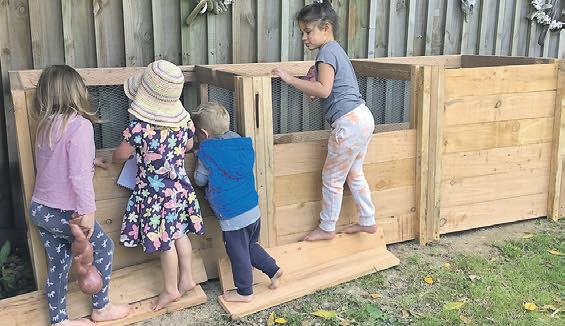
“We now have a gorgeous three bay compost bin system that allows proper compost practice – there’s one box in use for scraps and other organic matter, one for resting, waiting for the natural decomposition process to take place, and one fully composted and ready to add to fertilise the gardens,” she says, adding that their tamariki struggled to access and use their old composting system.
Earthwise Group managing director and owner Jamie Peters says the new composting system is a great way for the Bay of Plenty kindergarten to manage their waste footprint, and for



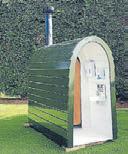

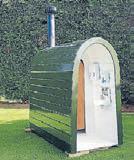

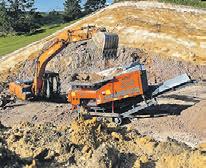

the children to learn about composting.

“When Te Puna Kindergarten shared their idea with us, we really loved that fact that it enabled their tamariki to use the compost bins themselves, and as such, learn as they go. Now, more than ever, composting and reducing waste is so important.
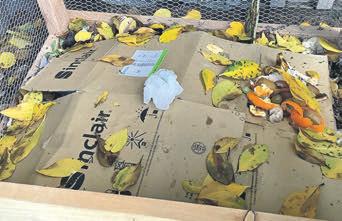
“It has been so great to see their idea come to life.”
In partnership with the Toimata Foundation (and their Enviroschools and Te Aho Tū Roa networks), the Earthwise Action Fund provides valuable funding for student and community-led sustainability driven projects.
In the Enviroschools network, Te Puna Kindergarten was one of 16 successful recipients from more than 96 applications from across New Zealand selected to receive support from the Earthwise Action Fund this year.
Earthwise, pioneers in eco-friendly products in New Zealand, and New Zealand’s favourite eco-friendly



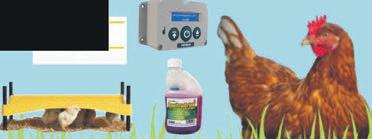

“We are delighted to be working with Earthwise to bring more opportunities to our nationwide networks. ere are so many inspiring initiatives in the Enviroschools and Te Aho Tū Roa networks, and e Earthwise Action Fund enables them to become a reality to bene t our tamariki and wider communities,” says Toimata Foundation strategic partnership manager Kristen Price.
“With sustainability at the heart of everything we do, this network shares a very similar ethos to us. To continue to empower the next generation of young people and make a meaningful di erence in communities across New Zealand,” says Jamie.
FiberFresh LIFESTYLE® isasafe,natural, healthy,consistent,nutritiousfibrechoice, suitableforallgrazinglivestock.
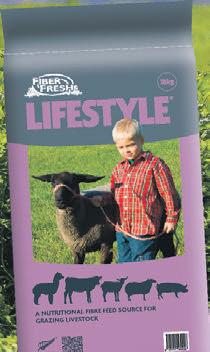


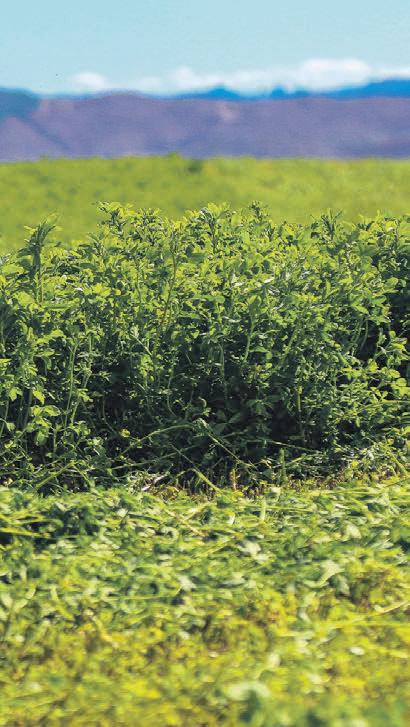


While dairy cows are dry and the wait for calving begins, dairy farmers are a orded a valuable window to use the hours freed up by not milking once or twice a day, to complete other tasks around the farm.
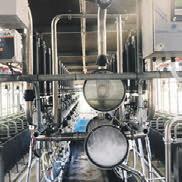
Where quoted below, Dairy Industry Awards Waikato 2022 Share Farmers of the Year, Brian Basi and Rachel Bunnik, share some of their thoughts on what they do and what they have seen other farmers doing to make the most of the extra man hours.


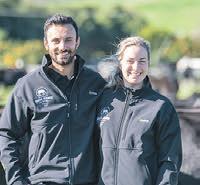
“For many farmers, the dry period is when they are moving farms themselves or they are settling in new sta coming to their farms and need to have them ready for calving. It’s a busy time preparing a house/ farm for the arrival of a new manager or sharemilker and all their equipment,” says Rachel.
Many farmers take the opportunity to have a holiday. is can be easier on larger farms with several sta ,




but over the Christmas period is often more appealing to farmers with children. “Late summer and autumn can provide an opportunity to carry out earthworks and race repairs before it gets too wet,” says Brian.


On some occasions when farms have newly built dairy sheds, the dry period can o er a great time to move any plant and equipment from the old shed into the new prior to calving commencing.

“We use the time to carry out any maintenance and equipment servicing in our shed and milk room. Spraying the concrete with chlorine and replacing the milk liners on our clusters are two of the regular jobs on our list. It’s also a good time to service the e uent system and lay any new concrete where needed,” says Rachel.
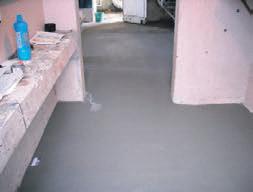


April, May and June are good months for planting trees, whether it be riparian planting, shade planting or shelter belts.
“While we always clean up after calving so we can use the sheds for storage, there is always a thorough clean prior to calving. Bird and animal droppings need clearing away, pens need setting up with clean gates.
“Fresh wood chip is laid, and we always replace all the teats on the







feeders. Strict hygiene protocols are essential with newborn calves,” says Brian.
Some farmers use the time to recon gure their paddocks and fencing can be easier in the winter when the ground is softer.
Tractors, farm bikes and implements that aren’t being used at this time can have services scheduled to coincide with the dry period.
Not all the work is physical. Rachel and Brian carry out desk work, which requires computer time and discussion, as well as regular farm walks.
“We spend a lot of time planning out our winter management plan, and a contingency wet management plan. How the land is managed is crucial, especially to minimise pugging damage which has an in uence on our environmental impact,” says Rachel.
“We plan the mating of our herd, picking our bulls for next season and looking at the performance of the last season and what changes to mating, feed, pasture management and production we want to make,” says Brian.
Regardless of whether the timing of the dry season is for autumn or winter calving, each one o ers an opportunity to achieve other tasks while not milking.
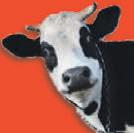
Infrapipe Ltd is a small business that makes and employs product locally in Auckland, New Zealand.





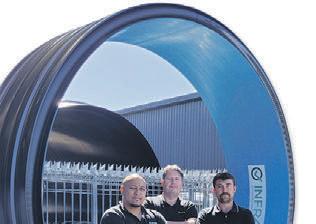
“At Infrapipe Ltd we aim to look after the most important things that matter, our people, who include sta , customers and suppliers, and of course our planet, by having a complete no wastage manufacturing system and reusing other businesses and consumers waste plastic.”
Infrapipe Ltd is proud to manufacture Ecopipe, which is an environmentallyfriendly HDPE manufactured culvert pipe.


“Using our Infrapipe spiral wound technology, we can guarantee Ecopipe is one of the strongest engineered culvert pipes on the market.
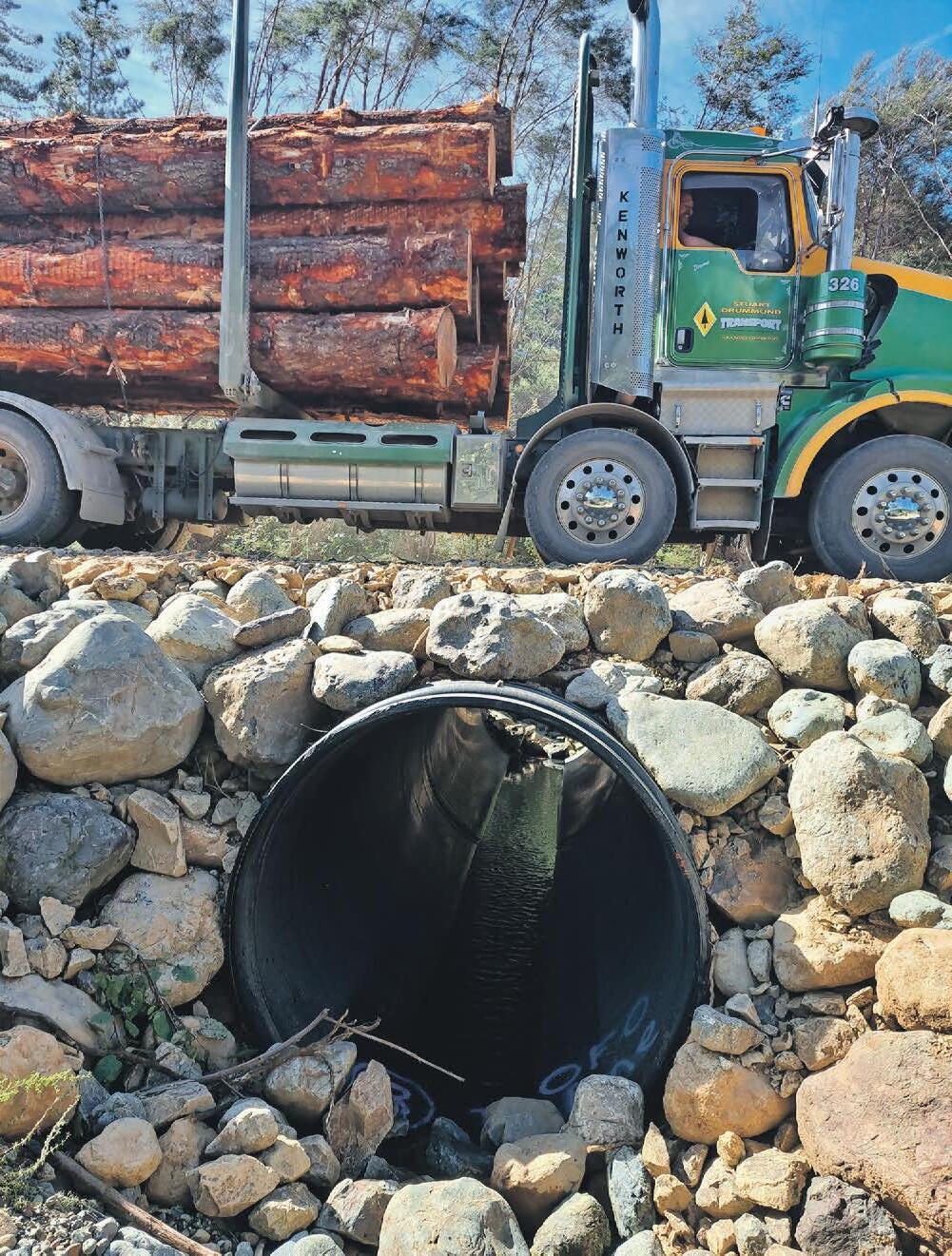
“Beyond the obvious environmental advantages, there are multiple bene ts to choose Ecopipe that can save you time and money during the installation process and the product’s lifetime expectancy.”
Ecopipe has a number of uses such as farm and forestry culverts, accessway
culverts, civil temporary works, piping water races/creeks and of course stop bank culverts.

So, what do you need to know about Ecopipe?
It is made from recycled HDPE civil pipes and sometimes high-quality postconsumer plastic like milk bottles. It is incredibly strong and only needs 600mm of soil cover to be tra cable.

It o ers male and female push t connections with rubber rings included. Ecopipe can be drilled/perforated for drainage which does not a ect its strength – and it’s light and easy to handle and install, saving you money.
Ecopipe can be adapted in many ways to t to existing pipes such as concrete, PE or PVC culverts and can even have ood gates attached if required.
I haven’t written for a while, but an update on where we are is in order.




With the launch of Total Replacement erapy in November 2019, we felt we had answered the call to help farmers dramatically reduce synthetic nitrogen without loss of pro t.
By rigorously following a strict, eightstep plan, the 20 farmers that went on the plan have had outstanding results, in a very short time.

We have not only seen an 86 per cent drop in synthetic nitrogen within 18 months, but increased clover ground cover by up to 70 per cent and pasture roots descending to one metre in the same time.
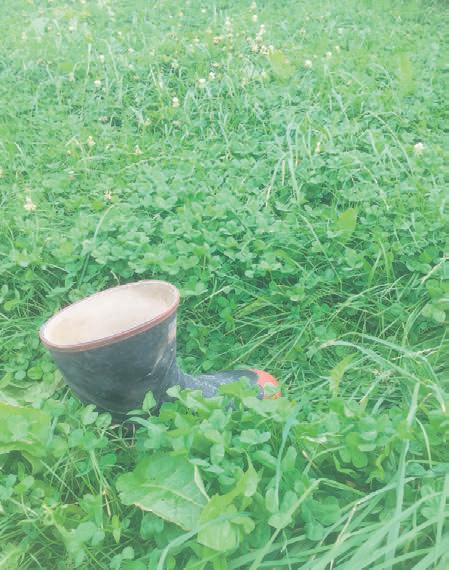
Seeing these consistent results was enough to safely say the eight-step plan is working.
Having reported, marketed and shared all the data we gathered, we felt we had completed the marketing plan of the Total Replacement erapy concept.





So, we thought, what’s next?
We decided to peer review our pathway, using Dr Lucy Waldron. We aimed to nd out what established science already existed in the programme, so we performed a literature review of peer-reviewed, established science that was part of the eight-step plan, at our own cost.
e next part was to work out the areas that were not covered, and needed to be scienti cally proven. is needed eight replicable, funded new farm trials to measure the science.
To do this, we needed to apply for funding. We were encouraged by funding administrators to apply for large amounts
of funding because we had a corporate structure. We put an extensive presentation together, but two days after it was received, the application was declined.




Apparently, after seeking outside advice they were told that our results – replicated on 20 farms – were “impossible”, and, “we don’t fund impossible”. We were also told that any further applications from us would be declined.
So, we’ve taken a new tack. We won’t bother to apply for funding again; instead, we will focus on what we do best – helping farmers reduce synthetic nitrogen without loss of pro t.
“We are still actively looking for farmers to volunteer to be part of the trial,” Dr






Waldron says. “Once we undertake the scienti c trials on farm, we get that science peer reviewed, which will give the eight-step plan integrity and give farmers con dence to use the programme.”
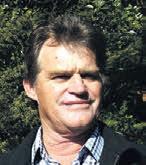
With Total Replacement erapy, we are totally replacing synthetic nitrogen with a biological system. As we strictly go through the eight-step plan, there is a transition period, which includes that the soil be balanced before any liquid fertilisers are added.
We also don’t restrict a farmer if he wants to use synthetic nitrogen during this time.


As we follow the eight-step plan, we see a change in the soil, and once we start applying the liquids, we start seeing a reduction in the dependence on synthetic nitrogen at around eight months. Our scienti cally formulated liquid combinations change the farm completely, and totally replaces a chemical system with a biological system.
We are against the concept of regenerative farming, because of its lack of transition time and advocation for no fertiliser. Regenerative farming bases its theories and programmes on land that has balanced soil already; but if the soil is not balanced, and you stop applying fertiliser abruptly with no transition plan, the farm will not cope. One such farm on a regenerative programme was failing with reduced fertility and reduced feed grown on the farm. So, we put that farm on Total Replacement erapy and we are seeing exactly the same trends that our other farmers have experienced.
Scientists have proved that without a transition plan, the cost to the farming industry will be huge. If you are going to a new system, you need to understand what system you are moving from.
For example, a chemical system is a plant-feeding system; when the plants are given synthetic fertiliser as a plant feeder the plants use up what is needed, grow the grass well and when the plants have used what they need they deliver the unneeded synthetic nitrogen to the roots. To the roots, this is like breakfast in bed; they don’t need to do anything.


In extreme cases, our measurements have shown that the roots in a chemical system are only 75 millimetres deep, which do not help the reduction of leaching. In farms under the Total Replacement erapy programme, we are seeing plants that start with these short roots extend root growth to 500 millimetre over nine months, and one metre at 18 months.
Trials and tests on a farm with a chemical system will show that there is an absence of biology, because the conditions aren’t right for biology to thrive. Synthetic nitrogen will survive in the absence of biology, whereas bio-stimulants will not work if there is an absence of biology – because there is nothing to stimulate in the rst place.
e Total Replacement erapy programme is very strict, and with the results we are seeing and the products we are using, we are con dent we can transition farmers to a biological system without loss of pro t, totally replacing synthetic nitrogen.



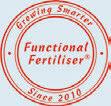
Christchurch and Dunedin manufacturing sites. Superphosphate contains plant-available phosphorus, sulphur and calcium, which are all essential nutrients for life. It’s an ideal option, along with agricultural lime for managing the health and productivity of New Zealand’s

As part of an ongoing strategy to front-foot global supply chain challenges, Ravensdown is trialling a new source of phosphate rock from Australia.
e shipment is on route to Lyttelton Port and Port Otago with 5000 tonnes of phosphate rock from the newly commissioned Ardmore Mine in Queensland, Australia.
“It’s early days, but Ardmore Phosphate Rock has the potential to form a part of Ravensdown’s nutrient o ering, helping to rm up local supply of high-quality Superphosphate for New Zealand farmers and growers,” says Ravensdown supply chain GM Mike Whitty.




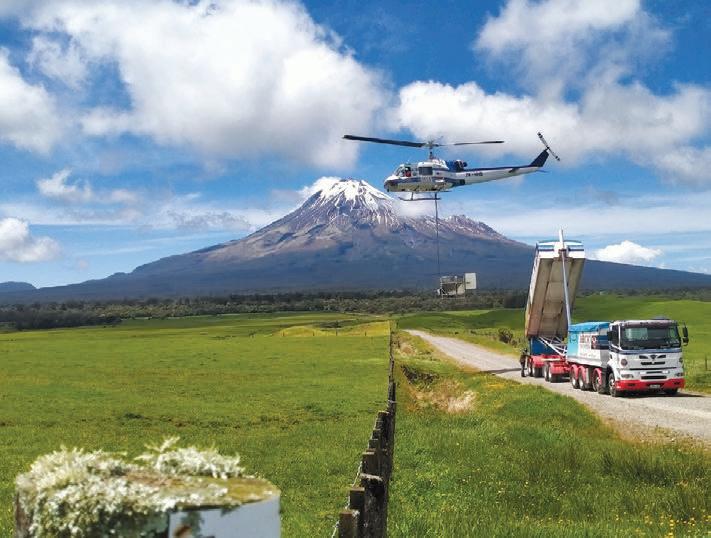
“If the past few years have proven anything, it’s the value of having more options.
“We’re operating in an ongoing environment of instability when it comes to managing supply chain risks and increasing costs.

“It’s a culmination of familiar factors, including the con ict in Ukraine, political tensions in other parts of the world, and we’re seeing that Covid-19 has a very long tail.
“ e lasting e ects of the pandemic reach beyond simple shipping delays, we’re also seeing less commodity exports as countries

like China intensify their focus on internal food security.

“As a Co-operative, it’s our job to identify and manage those risks on behalf of our farmer and grower shareholders. We’re committed to ensuring they have ongoing access to the essential nutrients needed to run their businesses.”
e trial shipment will undergo rigorous quality tests here in New Zealand.



e export operation at Ardmore Phosphate Rock Mine is owned by a 100 per cent subsidiary of Centrex Ltd, Agri ex Pty Ltd.
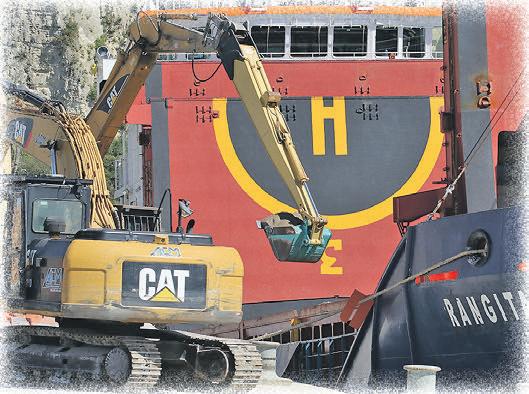
“We are delighted to be working with Ravensdown to introduce our product to the New Zealand market,” says Centrex CEO Robert Mencel.
“We have the utmost con dence in the quality of our phosphate rock and its ability to signi cantly reduce supply risk for our trans-Tasman allies.”


Ravensdown will continue to investigate and trial other sources of phosphate rock closer to New Zealand as part of our ongoing e ort to manage quality, surety and cost risks for New Zealand farmers and growers.





Ardmore Mine in Queensland Australia is a new source of high-grade phosphate rock.
e phosphate rock will be tested and processed at Ravensdown’s




After a considerable absence, Neal Kinsey is returning to New Zealand to present what could be his last introductory soil fertility course in NZ.

is is a comprehensive alternative course that results in superior production and pro t for those that follow the protocols explained. It will be held on May 1 to May 3 at e Function Centre, Brancott
Obvious, isn’t it? Equilise helps take care of horses by looking after the soil.
Winery, Main Road South, Blenheim. is course covers three days of teaching the principles of covering soil biological, physical, and chemical health, as is practiced in 75 countries around the world, yielding superior results when compared to just focussing on the chemical side of fertilisers.
is is about truly sustainable soil improvement and health.

Some of the subjects that will be covered are: microbial plants in soil, soil content, soil physical properties, how soil amendments work, cation exchange capacity, cations, you can’t manage what you can’t measure, calcium, magnesium, nitrogen, (and how to reduce N applications) phosphorus, potassium, sulphur and micronutrients.
Please refer to the website: www.kiwifertiliser.co.nz for more details and registration. Go to Events, then Upcoming Events.
Neal is being hosted by Golden Bay Dolomite. e course he will take at Blenheim has been taught in NZ and in other parts of the world many times before and will use relevant NZ examples.
Visit us at www.cplimesolutions.net.nz or call 0 508 678 464 for more information
It is important to build a suitable environment in the soil using calcium and magnesium for microbes to ourish.
Trace elements are also important and are often targeted for plants.
ey should be targeted at animals, as most microbes are animals. Some soil tests do not even measure them; so trace elements are not applied. Is it any wonder some farms frequently have costly animal health problems?
ere will be good advice on o er for farmers and reps involved in all types of farming and growing. Dr Linus Pauling, winner of two Nobel Prizes, stated: “In my opinion, one can trace every sickness, every disease and every ailment to mineral de ciency”.
If you accept this statement, then improvements can be made in the following areas by improving fertiliser practices: Stock health; insect problems (including ticks and mites) on stock, pastures and crops; bacterial and fungal diseases, facial eczema; dipping, drenching and dagging regimes; fruit and vegetables that do not keep; and are either tasteless or sour; Psa of kiwifruit; weeds including YBG; the need to inoculate silage; or the fact that large areas of pasture have to be re-grassed each year.
Chemical sprays and similar therapeutics can be greatly reduced over time.

One test for a dairy farmer is the e uent pond. If it is anaerobic, it will crust over and require constant and costly maintenance.
If it is aerobic, no such problems will occur. e pond re ects the health rest of the property. If it is not healthy, then neither are the soil or the stock, and that can easily be avoided.
All the above problems are directly related to soil fertility and can be mitigated to a greater or a lesser degree.


e Fertiliser Association of New Zealand has just published its 2023 Code of Practice for fertiliser nutrient management.
“Our new Code of Practice is a key resource tool for the management of nutrients on arable and pastoral farms, horticulture and viticulture blocks, and market gardens,” says FANZ CEO Dr Vera Power.
“It was launched at an event in Wellington on March 13, attended by the Minister of Agriculture, Hon Damien O’Connor.
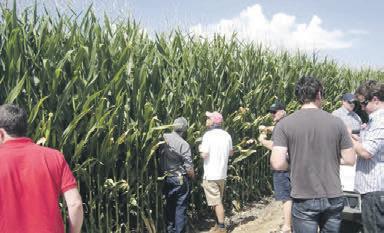
“ e revised Code provides clear principle-based guidance on supplying nutrients for growing healthy food.”
Vera says following the Code provides users, regulatory authorities and markets con dence that the nutrients used in Aotearoa New Zealand primary production are managed in a way that minimises adverse environmental impacts.

Digital versions of the Code are available for download from the FANZ website – www.fertiliser.org.nz

Printed copies are available on request by emailing: info@fertiliser.org.nz
“We encourage you to share this news with colleagues and stakeholders, and welcome any feedback you may have on this revised edition.”

e major winners in the 2023 Bay of Plenty Dairy Industry Awards, Cameron and Jessica Lea, say being surrounded by a strong mentor network has set them on the path for success.

e couple were announced winners of the region’s Share Farmer of the Year category at the Bay of Plenty Dairy Industry Awards annual awards dinner held at the Awakeri Events Centre last month.
e other big winners were Chihiro Hanyuda who was named the 2023 Bay of Plenty Dairy Manager of the Year, and Caleb Spence, the 2023 Bay of Plenty Dairy Trainee of the Year.
Cameron, 32, and Jessica, 31, are 50/50 sharemilking over two farms – Colin and Maria Eggleton’s 120ha Opotiki 270-cow property, and Bern and Heather Mcdonals’ neighbouring 100ha, 300-cow property. ey won $11,300 and three merit awards.

Entering the Awards previously gave the Leas an opportunity to assess where their business was heading and actively set goals.
“It also provided a wonderful environment to network with other farmers and rural professionals.”
Cameron grew up on a dairy farm and after a small stint farming after leaving high school, worked in Australia and New Zealand as an agricultural contractor.
“Farming is a great lifestyle to raise a family,” says Jessica.
“Everybody helps when jobs need to be done and we have the exibility of juggling farm work with attending school functions, or heading to the beach for the afternoon.”
e Leas are looking forward to their continuing journey in the dairy industry and are excited about their clear path to farm ownership.
e couple applaud the positive advertising from industry leaders and hopes it helps to change public perception around dairying.
“Farmers bring so much to New Zealand’s economy and we generate work for so many industries that surround the dairy industry.”
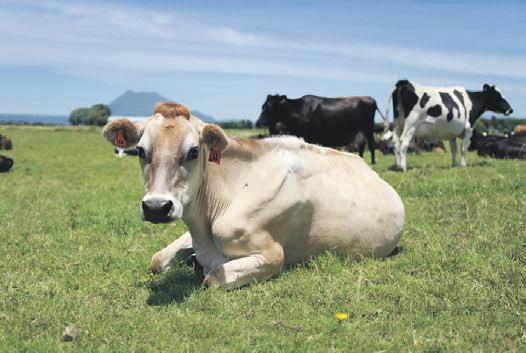
Challenges have included nding sta on their steep hill property, as the location can be oputting for some.
“If we want to achieve our goals, we have to be the driving factor.”

Jessica holds a Certi cate of Agribusiness Management from Open Polytechnic, while Cameron is currently studying towards PrimaryITO Diploma Level 5.
“We’re proud to be where we are now, sharemilking two neighbouring farms, from where we began several years ago.”
Share Farmer Merit Awards:
DairyNZ – People and Culture Award: David Leeder & Mere Edwards
Ecolab Farm Dairy Hygiene Award: David Leeder & Mere Edwards
Federated Farmers Leadership Award: Stefan & Rachel Grobecker
Honda Farm Safety, Health and Biosecurity Award: David Leeder & Mere Edwards

LIC – Animal Wellbeing, Recording and Productivity Award: Cameron & Jessica Lea
Meridian Environmental
& Feed Management Award: Dayna Rowe
BlackmanSpargo Rural Law Ltd



Sustainability
Award: Cameron & Jessica Lea
Ravensdown Sustainable Pasture
Award: Stefan & Rachel Grobecker
Perrin Ag Business Performance
Award: Cameron & Jessica Lea
QCONZ Emerging Talent Award: Stefan & Rachel Grobecker
Dairy Manager Merit Awards: DeLaval Livestock Management
Award: Chihiro Hunyuda
Fonterra Dairy Management Award: Chihiro Hunyuda
Whakatane District Council




Environmental Sustainability



Award: Chihiro Hunyuda
Pioneer Brand Products Pasture
People & Leadership Award: Lindsay Williams
Stem Rural Accountants Personal

Planning & Financial Management
Award: Dayna Rowe
Vetora Bay of Plenty Emerging
Talent Award: Liam Pirini
Dairy Trainee Merit Awards: DairyNZ Practical Skills Award: Keegan Blennerhasset
PJ Brogden Contracting Emerging
Talent Award: Waitangi Park
I.S Dam Lining Farming Knowledge

Award: Caleb Spence
King Farm Services Ltd



Communication & Industry Involvement Award: Fergus Hamilton.







A passion for success, combined with a desire to get ahead and the ability to be exible in an ever-changing dairy industry is a winning recipe for a Taupo couple. Kevin and Nicole Oppert were announced the winners of the region’s Share Farmer of the Year category at the Central Plateau Dairy Industry Awards annual awards dinner held at the Rydges Rotorua last month.
e other big winners were Mohammed (Jay) Ari n, who was named the 2023 Central Plateau Dairy Manager of the Year, and Jasmine Hall, the 2023 Central Plateau Dairy Trainee of the Year.
Due to entrants withdrawing from the Share Farmer category, Central Plateau Share Farmer entrant scores were benchmarked against the national average, with data collated from the 10 other regions. is also means merit awards were awarded if the entrant achieved at the right level. Kevin credits his 2017 experience as a Dairy Manager entrant as giving him a better understanding of his management techniques,
which led to their rst contractmilking position.

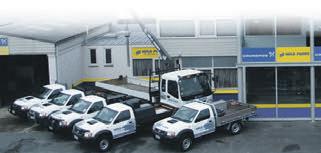
“We both loved being outside and have a passion for animals and working on the land,” says Nicole. “We love all aspects of farming –the challenges and all.”
e freedom and space they have to raise their family makes dairying an appealing career choice. “It’s a lifestyle as well as a career for all of us to love.”
e Opperts contract milk for Roger and Amanda Garland, on a 178ha Taupo property, milking 560 cows. ey won $14450 in prizes and four merit awards.
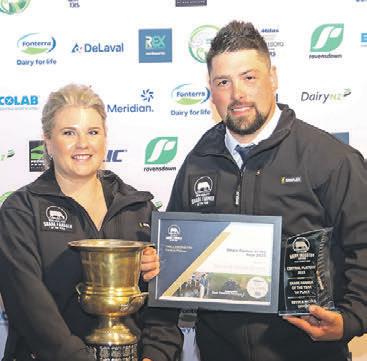
drives us to succeed even when times are hard – tomorrow is always another day!”
e Opperts are proud of achieving record production on di erent systems and of progressing their careers from farm assistant in 2009 to self-employed contract milkers. Nicole and Kevin, both aged 30, identify people as a strength of their business.
“We create an optimistic team environment where everyone feels included, with open communication with the owner and employees.”
“Our relationship with each other is also a strength,” says Nicole.
“We support each other’s decisions, have the same goals for the future, work well together and both have the drive to run a successful business.”
Future farming goals include equity partnership on their current contract milking role as they love the farm, location, herd size and community.
“We have the passion for success, the drive to get ahead and to adapt to the ever-changing dairy industry.”

Farming background

e winner of the 2023 Central Plateau Dairy Manager of the Year competition, Mohammad (Jay) Ari n, came from a farming background in Indonesia before arriving in New Zealand in 2008.

Kevin and Nicole are excited about the use of technology in farming and where this might lead, in on-farm scenarios as well as recording and admin.
“We’re young and versatile enough to adapt and t into any future within the dairy industry.”
e couple are frustrated at the negativity “around the one per cent of the industry – 99 per cent of farmers strive for healthy animals and productive land”.

ere have been a few challenges in their career, including sta , growing equity and starting their own business at a young age.

“Each morning is a morning closer to reaching our goal of potential farm ownership,” says Kevin. “Our family
He works on the Wairarapa Moana Incorporation’s Mangakino 289ha property, milking 1055 cows.

He won $9047 in prizes and three merit awards.
“I entered the Awards for the rst time this year as I want to be more involved in the dairy industry and gain new experiences.”
“Farming is my passion, and I love being on-farm and seeing my cows healthy and happy.”
During challenging times on-farm Mohammad calls upon that passion to stay motivated. “It’s my responsibility to achieve my goals.”
e 42-year-old is proud of his achievements in the Wairarapa Moana Awards over the
past few years, including: Dairy Unit of the Year, Nga Tangata (Developing People), Financial, Values and Farm Pride and winner of Whakamaru School biggest bull calves competition for three consecutive years.
“I began at the bottom of my career in New Zealand and have had good support and progression opportunities from my employer,” he says. “I’m proud of where I am in my current role.”
e 2023 Central Plateau Dairy Trainee of the Year, Jasmine Hall, is a rst-time entrant who saw the Awards programme as an opportunity to learn new skills and gain feedback.
“I was inspired by a previous title winner and the opportunities and experiences the Awards opened up for her,” says Jasmine.
“Seeing her video resonated with me and has shaped my progress in the industry. I’m passionate about working with progressive and passionate farmers and continuing to upskill myself.”
Jasmine is a farm assistant on Stu and Anne Koopal’s 204ha Rerewhakaaitu property, milking 560 cows. She won $7000 in prizes and two merit awards.
Growing up, Jasmine’s parents farmed at Waiotapu and she counts herself lucky she spent most of her time outside on the farm.
“ ey gave me my love of farming and being outdoors, and milking cows became the obvious choice when I was looking for my rst job.”
She began relief milking while still at school and enjoys the farming lifestyle.
“Working with people that have values similar to mine means I can push myself to take opportunities and progress, whilst having exibility and balance within my job means I enjoy going to work and my life outside of work also.”
“I was very academic at school, and wasn’t encouraged to go farming by my parents or teachers.


“I was advised that the only way for me to be successful was to study for an academic degree.”
e 20-year-old is excited about the future of the New Zealand dairy farming industry.
“New Zealand has some natural advantages for producing the best grass-based milk in the world.”

“ ere are so many young, passionate farmers and professionals embracing technology and changes which also helps to drive the environmental and animal health improvements that the industry is making.”

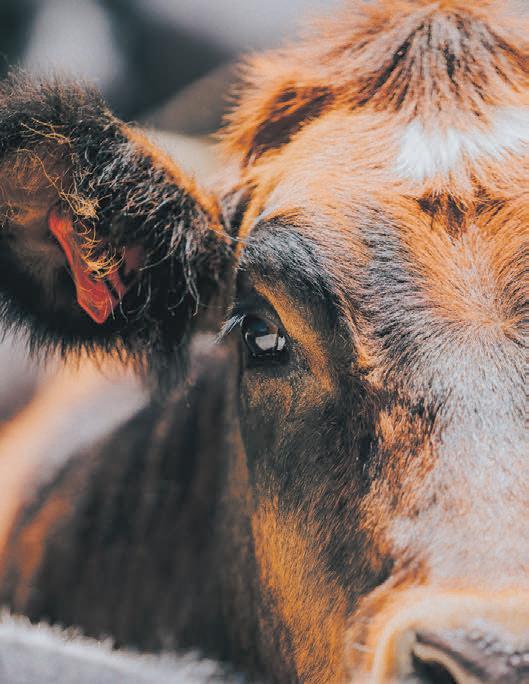
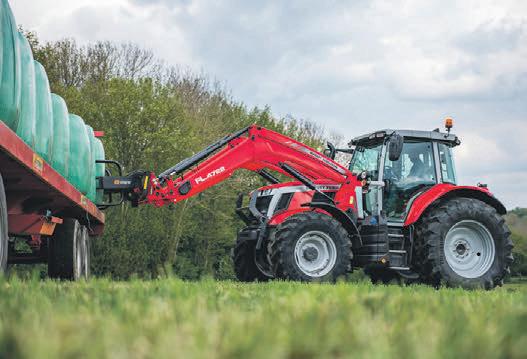
Jasmine’s future goals include continuing to learn in her current role before travelling to Australia to experience farming there, before beginning a Diploma of Agriculture at Lincoln University in 2024.
“Taking time between school and continuing to study means I am con dent this is the right
pathway for me.
A self-confessed cow lover, Jasmine says it’s really just a love for the cows that gets her out of bed on cold and rainy mornings.
“One of the things I’m really proud of is being given the responsibility to manage all of the calves on our farm this year,” she says.
“I’m really passionate about growing quality heifers and am thriving on the challenge of having the best calves I can.
“ is opportunity is teaching me about all aspects of managing stock, especially pasture management and feed allocation.”
Share Farmer Merit Awards:
DairyNZ – People and Culture Award: Buddhiya
Alankarage & Chamila Mudalige
Ecolab Farm Dairy Hygiene Award: Buddhiya
Alankarage & Chamila Mudalige
Federated Farmers Leadership Award: Buddhiya
Alankarage & Chamila Mudalige
Honda Farm Safety, Health and Biosecurity
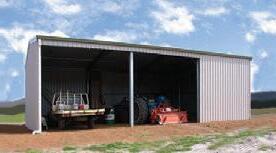

Award: Kevin & Nicole Oppert
LIC – Animal Wellbeing, Recording and Productivity Award: Kevin & Nicole Oppert
Meridian Environmental Sustainability Award: Kevin & Nicole Oppert
Ravensdown Sustainable Pasture Award: Buddhiya
Alankarage & Chamila Mudalige
Stretton & Co Business Performance Award: Kevin & Nicole Oppert

Dairy Manager Merit Awards:
DeLaval Livestock Management Award:
Mohammed Ari n
Fonterra Dairy Management Award:
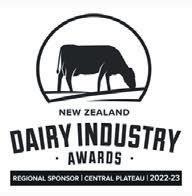
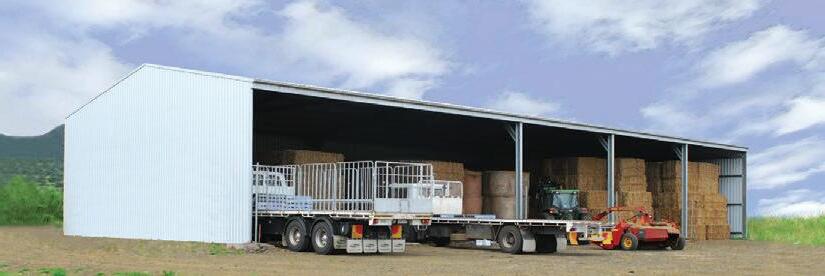
Mohammed Ari n
I.S Dam Lining Ltd Environmental Sustainability
Award: Ben Purua
NZ Farmers Livestock Ltd Pasture & Feed Management Award: Liam Sangster
Vetora BOP People & Leadership Award: Ben Purua
Perrin Ag Consultants Ltd Personal Planning & Financial Management Award:
Mohammed Ari n
Armer Farms N.I Emerging Talent Award: Gene Turuwhenua
Dairy Trainee Merit Awards:
DairyNZ Practical Skills Award: Jasmine Hall
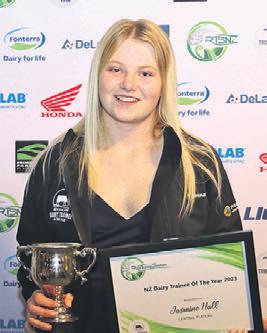
T H Enterprises Ltd Emerging Talent Award: Tamiti Wineera
BlackmanSpargo Rural Law Ltd Knowledge

Award: Jasmine Hall
Rotorua Lakes Council Communication & Industry Involvement Award: Shanyn Ruthe
145-210HP, 6.6L AGCO POWER engine with no ADBLUE, and all the creature comforts in the cab.

MIKE ROGERS: 021 998 819 (ROTORUA/REPOROA & SURROUNDS)

TONY JOHNSTON: 021 349 816 (WHAKATANE/TE PUKE & SURROUNDS)
JAMIE GAINSFORD: 021 905 458 (TAUPO & SURROUNDS)

e major winner in the 2023 Waikato Dairy Industry Awards has a genuine passion for all things farming and believes there are many opportunities within the dairy industry for those who are willing to work hard and push themselves. For the rst time, a sole female farmer has won the Waikato Share Farmer category.
Aleisha Broom eld was announced winner of the region’s Share Farmer of the Year category at the Waikato Dairy Industry Awards annual awards dinner held at Claudelands Event Centre last month.

e other big winners were Sam Dodd, who became the 2023 Waikato Dairy Manager of the Year, and Natasha Price, the 2023 Waikato Dairy Trainee of the Year.
Aleisha is a 50/50 herd-owning share milker on the Dibble Family’s Tauhei Farms Ltd 86ha Te Aroha
farm, milking 245 cows.
She won $15,828 in prizes and four merit awards.
She was runner-up in the same category last year and believes working on her business was a key bene t of the awards programme.
“As well as learning more and improving my business, I enjoyed meeting the other entrants and regional teams,” she says.
“It was great to have the recognition of hard work.”
In her DNA e 33-year-old was born and raised on a dairy farm in Patetonga and says farming is in her DNA.
Aleisha holds a Bachelor of Agricultural Science with First Class Honours from Lincoln University and a New Zealand Diploma in Agri-business. e former DairyNZ consulting o cer and PrimaryITO tutor says her favourite part of farming is the cows. “I absolutely love the cows!”
“I’ve always wanted to be a farmer and give future children the rural upbringing that I had,” says Aleisha. “I really enjoy working with the animals, in particular growing exceptional youngstock, and having happy, healthy cows that have low SCC and high in-calf and production results.”
She also identi es a traditionally stressful time on-farm as her favourite – calving.




“It’s also important for me to continually develop, so I have been doing a lot of training which helps improve the business and keeps you motivated.”
Aleisha is proud she is a sharemilker in her own right, with an 82 per cent six-week in-calf rate and 52,000 SCC.
Together with her partner James, she is about to realise a life goal and purchase a dairy farm.
“James and I have both worked really hard in our own businesses to get to where we are today,” explains Aleisha. “We are going into business together in June to purchase our own dairy property which has been a goal for both of us for a long time.”
“Anyone who knows either of us will know that there will be lots of vigorous debate on farm –
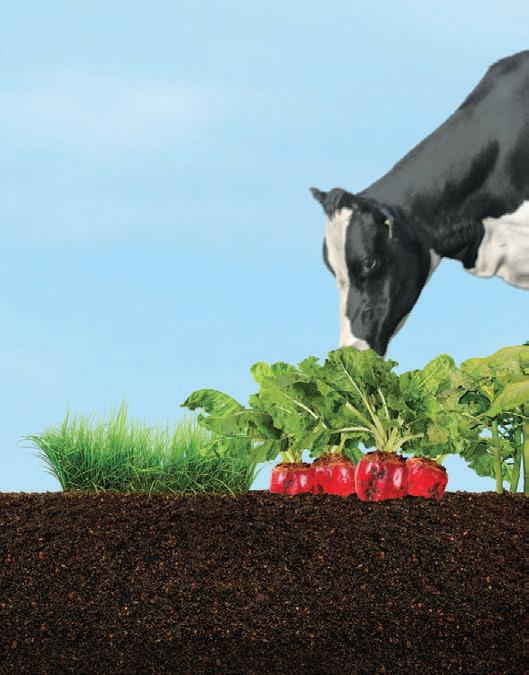
particularly about what colour cow we are going to milk!”
e second-time entrant would like to improve the rural-urban divide to ensure that others – both nationally and internationally – can see the great work farmers are doing.
“I’d like to help attract more people to the industry who can see the bene ts of running their own businesses and provide more support for those people as they progress up the ladder, so they stay dairying.
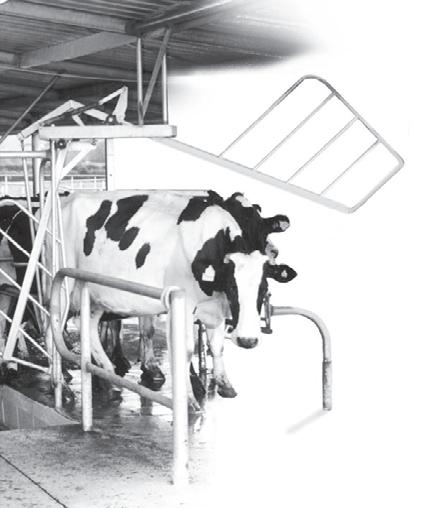
“ ere are some headwinds and challenges but as an industry we need to work together to all pull in the same direction.”
Aleisha believes the strengths of her business lie in the proven on-farm performance regarding cows and pastures.
“I have a genuine passion for all things farming, particularly pasture management which allows us to get good performance at a lower cost than others.
“Excellent cost control in the business as well as personally has allowed me to make strong pro ts year-on-year and build equity.”
Future farming goals for Aleisha include the dairy farm purchase in June.
“James and I would like to grow that dairy farm to a decent size where it can support a sta member, run a pro table business, and grow our family.”
e winner of the 2023 Waikato Dairy Manager of the Year category was the 2020 Taranaki Dairy Trainee of the Year and National Runner-up in the same category and says the bene ts of entering the Awards programme include benchmarking himself against others, networking and access to further skills and knowledge.
New skills

Sam Dodd won $10,025 in prizes and four merit awards. He is farm manager for Belinda Wilson on her 252ha Te Awamutu farm, milking 800 cows.
Prior to entering the dairy industry six seasons ago, Sam was studying to be a paramedic.
He made the switch to dairy farming and enjoys working outside with animals and the responsibility that comes with that.
“You can see progress and see how your decisionmaking bene ts the business.”
e 26-year-old believes one of the most exciting things about the future of dairy farming is the number of people changing careers to begin dairy farming. “ ey bring new skills and perspectives.
Challenges have included extreme weather events from drought through to oods and Sam is grateful that he works for a very supportive family who have allowed him to have the growth and opportunities to be where he is today, and he also cites them as a strength of the business.
“On and o -farm support is huge and getting o -farm and sta inclusion is incentivised.”

Sam identi es being solution-based as a strength of the business.
“No matter what happens or where we are in the business, there is always a solution which means less stress and panic.

e 2023 Waikato Dairy Trainee of the Year is Natasha Price who was encouraged to enter the Awards by her employers (who are previous Waikato Farm Manager category winners) and her Primary ITO advisor.
“For me, the awards present an opportunity to not only further my practical and theoretical farming knowledge, but to also gain valuable connections with like-minded and progressive people in the industry.”
Natasha is working as a farm assistant/2IC for Paul and Kate Manion on their 108ha property at Kiwitahi, Morrinsville, milking 280 cows. She won $7750 in prizes and one merit award.
Growing up on a small dairy farm on the Hauraki Plains, Natasha never considered dairy farming as a career option until she was helping her Dad on the farm during the 2020 lockdown.

“I always enjoyed spending time with the cows on farm and had many friendly pet cows, however my knowledge of running a farm or the industry as a whole was limited.
“I spent a lot of time in lockdown researching farming as a career option on Dairy NZ and Primary ITO’s websites and the clear career progression and
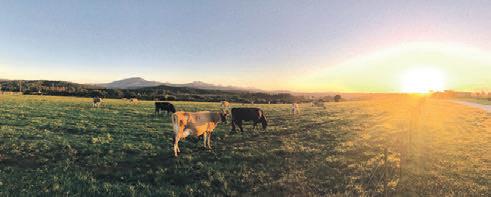

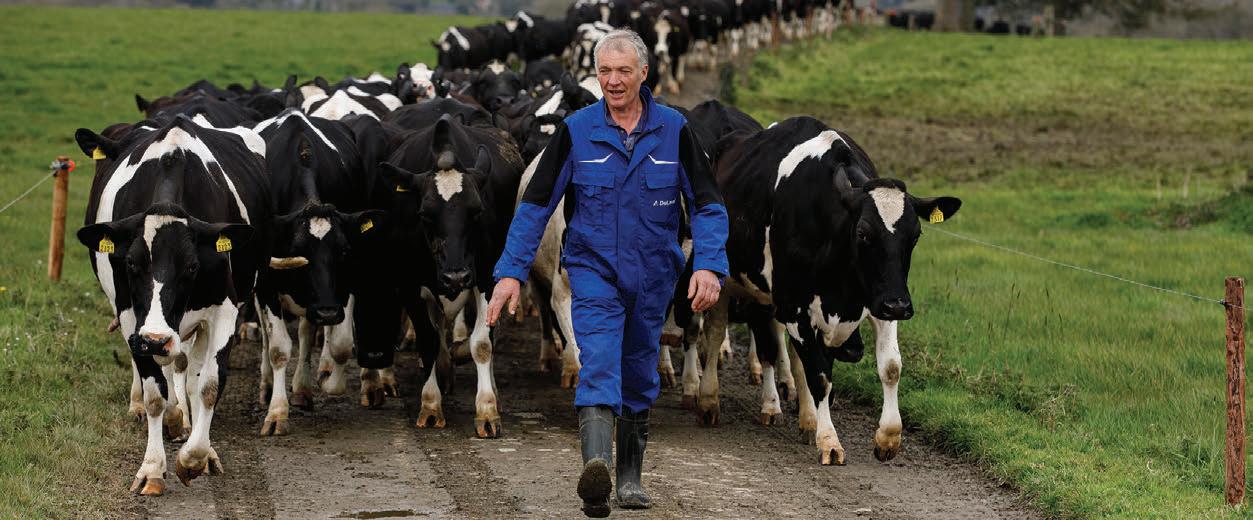
variety in day-to-day tasks were really compelling to me,” she says.
“I was also pleasantly surprised with the large female presence in the industry and the scienti c research that forms the basis of everything we do as farmers.
“ ese factors made farming seem like a pretty perfect t for me and after almost two years working on a farm, I can still say what I love most about farming is hanging out with cows every day.”

Natasha holds a Bachelor of Science with a double major in Zoology and Ecology at Massey University and completed Dairy NZs Go Dairy course in 2020. She is currently completing a New Zealand Apprenticeship in Agriculture with Primary ITO (level 3 and 4).
Natasha is excited about the use of technology in the dairy industry.
“I’m interested in the development and integration of science to make farming more e cient, humane and better for the environment.

“I am lucky enough to work on a farm that uses a cow monitoring system for cow health and mating. Every day I see the bene ts for sta and the cows and am eager to see how scienti c technology in the dairy industry changes and evolves in the future.”
Natasha’s future farming goals are speci c and include an OE working in the agriculture sector before returning to New Zealand to be 50/50 sharemilking then venturing o -farm into an agriscience role where she would like to give back to the industry through scienti c research.


“Another goal is to complete the Kellogg Rural Leadership Program as I believe this will be an important step in
understanding the primary sector and developing my leadership skills.”
Share Farmer Merit Awards:
DairyNZ – People and Culture Award: Logan Dawson
Ecolab Farm Dairy Hygiene Award: Nathan & Rebecca Hubbard
Federated Farmers Leadership Award: Chloe Mackle
Honda Farm Safety, Health and Biosecurity Award: Aleisha Broom eld
LIC – Animal Wellbeing, Recording and Productivity Award: Logan Dawson
Meridian Environmental Sustainability

Award: Aleisha Broom eld
Ravensdown Sustainable Pasture Award: Aleisha Broom eld
ANZ Business Performance Award: Aleisha Broom eld
Cow Manager Emerging Talent Award: Jen Hodgson
Dairy Manager Merit Awards:
DeLaval Livestock Management Award: Jon Paul Jackson
Fonterra Dairy Management Award: Sam Dodd

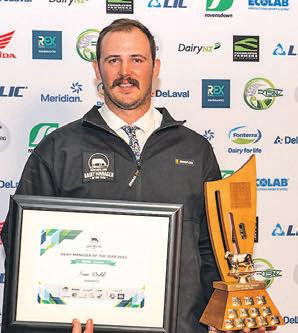
Bluegrass Contracting Environmental Sustainability Award: Sam Dodd
Seales Winslow Pasture & Feed Management

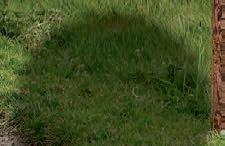



Award: Sam Dodd
Click Cover NZ People & Leadership Award: Sam Dodd
ANZ Personal Planning & Financial Management








Award: Sicelo Nene

I.S Dam Lining Ltd Emerging Talent Award: Manvir Singh
Dairy Trainee Merit Awards:
DairyNZ Practical Skills Award: Jack Brittenden
Trinity Lands Ltd Emerging Talent Award: Sheree Fitzpatrick
NZ Farmers Livestock Ltd Farming Knowledge
Award: Natasha Price
Waikato Farmers Trust Communication & Industry Involvement Award: Lauren Randall
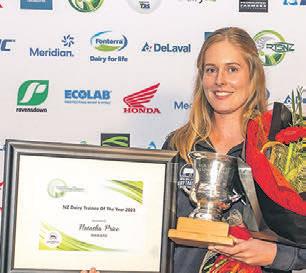

Cars and trucks are safely on the move again up No.4 Road in Te Puke thanks to the installation of a temporary Bailey bridge.
e familiar noise of vehicles using the bridge over the Raparapahoe Stream returned last month week following a six-week detour.
Western Bay of Plenty District
Council moved quickly to locate and install a Bailey bridge - a portable, prefabricated truss bridge - after the existing single-lane bridge washed away during the Auckland Anniversary weather event.
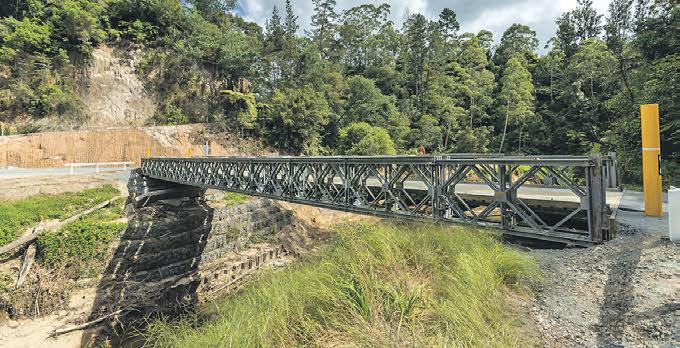
Mayor James Denyer says it’s pleasing to see the temporary bridge in place, reinstating a safe route for the around 30 impacted properties.
“ is temporary bridge provides residents the means to get back to some normality and with the start of the kiwifruit packing season getting underway, it comes at just the right time to provide suitable road access to the orchards.
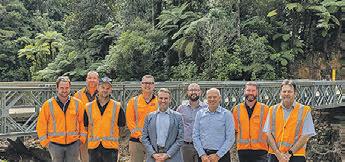
“It’s been a true team e ort to reach this point.


“From the residents who showed great patience and understanding in trying times, to the landowners who opened up their private accessway
while the installation was taking place, and the Council and engineering teams’ tireless mahi to get the bridge in place.
“A big thanks must also go to Waka Kotahi NZ Transport Agency for providing us with the Bailey bridge, otherwise none of this would be possible.”
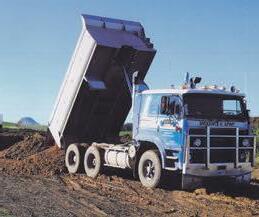



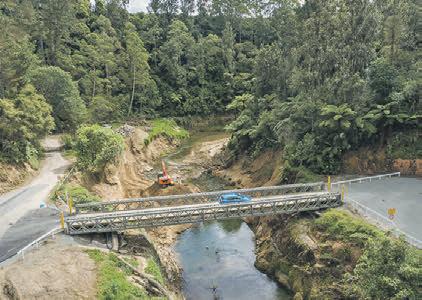
Plans for an initial seven-day installation were scuppered by an assessment showing unfavourable ground conditions, forcing a rethink and a number of additional works – making it a six-week project. is included, installing longer and larger piles (up to 25m into the ground) to support the bridge and its foundations, and ensuring the turning circle at each end of the bridge was wide enough to allow trucks with trailers to access the bridge also.
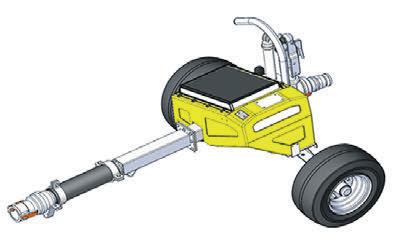
“Installing this Bailey bridge was not a simple process.



“How quickly they can be set up depends on how accessible the area is and the preparation work required, and in our case the ground conditions and intricacies of the installation meant we could only go as fast as this allowed,” says Council’s transportation manager, Jim Paterson. “Our goal from the beginning has been to do this correctly to ensure a temporary bridge that is safe and secure for everyone accessing it. is has been achieved.”
e Bailey bridge will be in place until provision of a permanent structure can be considered and installed.





“ e repairs must also be robust enough for stock trucks and machinery to restore farm tracks.”


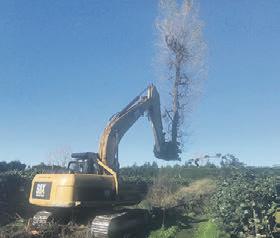
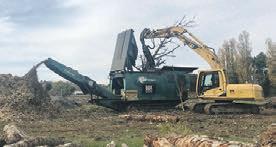



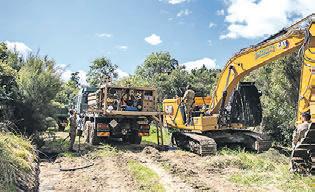
Sam was shocked by the damage caused by forestry slash throughout the East Coast and insisted the Ministerial Inquiry must prevent this from ever happening again.
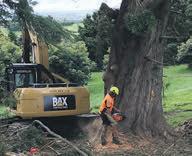
“People have lost their homes because of slash-induced ooding. Other people I have spoken to have had valuable farming land on the ats destroyed by forestry slash and silt,” he says.
Beef + Lamb New Zealand is urging the government to commit to road repairs for farmer still isolated following Cyclone Gabrielle.
“Cyclone-ravaged roads, particularly to remote properties, and the level of devastation caused by forestry slash are farmers’ main concerns. e scale of damage cannot be understated,” says chief executive Sam McIvor.
Earlier last month, Sam visited Hawke’s Bay farmers in Ōtāne, Rissington, and Glengarry, before travelling to Tolaga Bay, and Ruatōria, and video calling other Tairāwhiti farmers in Pehiri, Wharekōpae, Hangaroa and Rere.

“Many of the farmers I have spoken to are completely cut o and there is a small window of four to six weeks to move stock in and out of their properties. For some isolated farmers that window is shorter,” he says.
“ ere is a signi cant number of lambs that need to be moved o properties for processing or as store, and beef weaner sales aren’t far away.
“It’s critical that the Government prioritises roading infrastructure to these remote areas and provides clear communication on when this will happen.
“One farmer calculated it would cost $3000 per hectare to restore valuable ats and infrastructure back to production.”
Sam says farmers are working hard to restore farm infrastructure, tracks, fences and water systems, but the impact of forestry slash will be felt for a long time.
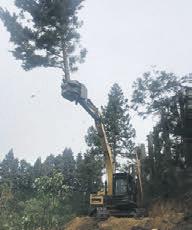
“It has destroyed countless kilometres of fencing, a signi cant number of bridges, valuable crops, blocked access to farms, and damaged farm infrastructure that will take farmers years to rebuild.

“Farmers face signi cant costs in reinstating land and infrastructure, as well as lost income and loss of land value.

“Farmers are also worried that this could happen again with the Government’s Emissions Trading Scheme and foreign investment settings allowing for large areas of food producing land to be converted into carbon price induced forestry. e Ministerial Inquiry must be thorough.”
Sam says it is critical that farming communities have their say after experiencing the devastating impacts of poor policy.
“We encourage farmers to keep reaching out and B+LNZ will keep advocating on their behalf.”
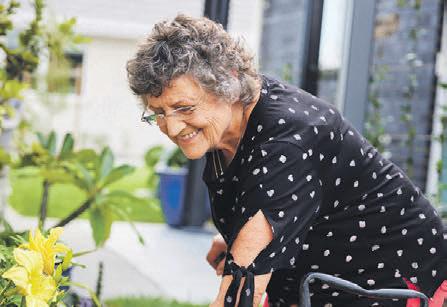

Murray Barton has the somewhat enviable job. He is the museum rebuild project leader for the Ross Bros Earthmoving Museum in Cambridge that was set up by the four Ross brothers (of C&R Developments).
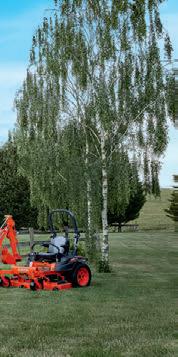
He tells the story of the acquisition of a 1958 Euclid TC-12 twin engine crawler tractor.

e American-made machine has two 227hp General Motors Detroit diesel 6-71 (incline) engines and


two Allison CRT 5531-1 (3-speed) transmissions.
With a combined output of 454 hp and a weight of 48 tonnes, the Euclid was far more powerful than any of the competition at the time.
Tight and accurate
“Each transmission could be controlled individually allowing for tight and accurate manoeuvring.


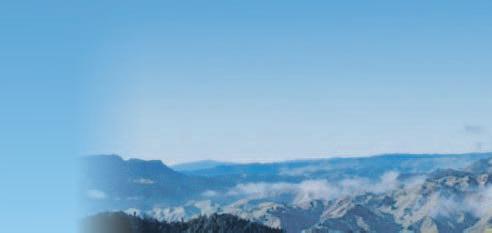



“ e oscillating track frames and central equaliser bar e ectively meant the machine was split



during times when there was no thought to save machines and preserve them. I helped dispose of them and repurpose them for scrap.
“One was sold locally but the Ross brothers bought it back 25 years later despite it being beyond repair.
“It sits at rest in the museum amidst a realistic display of overgrown New Zealand bush.”



down the middle allowing theTC12 to cope with uneven ground while still keeping both tracks on the ground,” says Murray.
Old machines repurposed
e Ross family had two TC-12s while they were operating as Baker Construction of Cambridge. “Sadly, their machines were sold



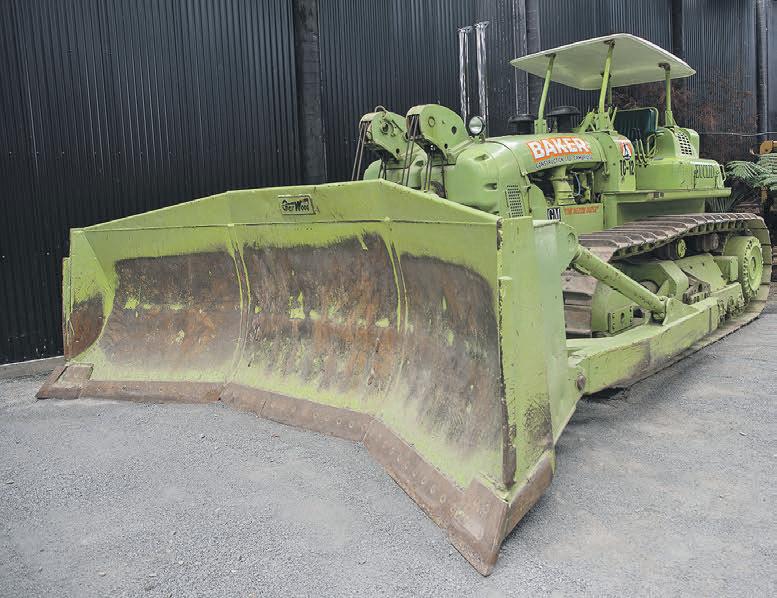
Machine from New York e acquisition of the second TC-12 started with a trip to the 2015 CONEXPO-CON/AGG Heavy Equipment Expo in Las Vegas. Youngest Ross brothers, Tim and Simon went along at the invitation of Caterpillar, to view the latest earthmoving machinery in action.
“Tim met a New Yorker with a similar business and they talked about the plant they used. When Tim realised he had a Euclid TC-12, he lit up and asked if he wanted to sell it.”

e working 1958 Euclid TC-12 and a ruined version to the right. continued...
Unfortunately it wasn’t for sale, but the pair kept in touch. However, years later, Tim received a sad phone call from his American friend who was winding up his a airs. He o ered Tim rst refusal on the purchase of
the TC-12 as he wanted it to go to a home where he knew it would be treasured.
“ is TC-12 was used in mines in New York State. Now branded with the historical Baker branding and well looked

after in the Cambridge Museum, the TC-12 is in good hands.
“It’s a collector’s piece that is taken to Wheels at Wanaka every two years and still working well.”
Catherine Frytailored to meet the client’s speci c requirements.


“Our company has added compressors and hand cleaners for road crews, water tanks and blasters for house washing businesses, small cranes for apiaries, extended decks and head-boards for trades, and even recycle cages on electric LDVs for waste collection.”

One of Pro-Deck’s most popular options is the tipping deck, which is utilised across a range of sectors. is feature adds another dimension of usefulness to the ute, and the tipping mechanism is powered by an electric pump that is operated through a switch in the cab.

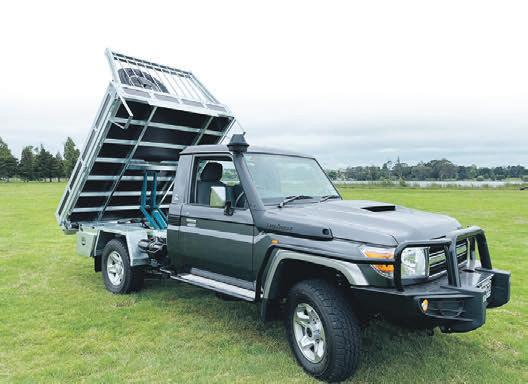
If you’re looking to maximise the usefulness of your ute, email Pro-Deck on: admin@vertec.co.nz




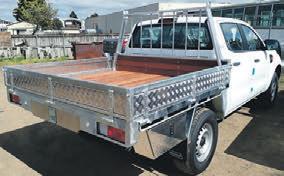
With their extensive range of customisable options and expertise in tting them, you can trust them to deliver a quality result.




Pro-Deck is leading the way in extending the usefulness of New Zealand’s utes.

e company manufactures, supplies, and ts a wide range of options that allow clients to customise their vehicles.
Pro-Deck managing director Jason Whitley says their services include replacing standard well-side or atdecks with toolboxes, cranes, tipping

units, stock crates, racks, water tanks, and more.
“We cater to a range of vehicles, from small double cab utes to six metre at deck trucks.

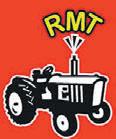
“All of Pro-Deck’s products are made in New Zealand using quality galvanised steel that is tough and durable, ensuring longevity.”
Jason says each t-out is unique, combining elements of Pro-Deck’s standard range with customisations

curriculum vitae
CV’s THAT STAND OUT. Don’t let your C.V. get lost amongst all the others. Get the WOW factor.

A C.V. For You can provide you with a personal and professional touch. From scratch or update existing ones. Check out samples on www.facebook.com/acvforyou or Ph/text on 021 27 27 912.
LIST YOUR EVENT HERE!

for sale
PULLETS HY-LINE BROWN, great layers. Phone 07 824 1762 www.eurekapoultryfarm.weebly.com
* your listing *
DO YOU HAVE something to sell or looking to buy or promote your business? List it here for only $23 for up to 20 words. Email office@ thesun.co.nz or call 07 578 0030.


email with ‘Rural Event’ in the subject line to: editor@ coastandcountrynews.co.nz (must be under $50 or free)








April 5
Historical Sabre Fencing, 5.30pm, outside Whakatane Harrier Club. Every Wednesday. Ph/txt David 0210 275 0398.
April 10
National Jazz Festival, Tauranga. See jazz.org.nz
April 13
Dancing with the Dandelions Talk, 7pm, Wesley Church Hall, 13th Ave, Tauranga. See letslearn.nz/taurangaherb-society
April 14-18
Balloons over Waikato. See balloonsoverwaikato. co.nz

April 16
Plant Fest, 9am-3pm, Racing Tauranga, Greerton, Tauranga, $16. See tinyurl.com/3v4dfctz


E-waste Collection, 9-11am, Cambridge High School, Cambridge. See urbanminers.nz/ collection-calendar
Echo Walking Festival, Waikato, Coromandel & Western Bay of Plenty. See echowalkfest.org.nz

April 22
Guided Bush Walk to Hunt Fungi, 1-3pm, Paengaroa, $40. See tinyurl.com/ywu83t3x
April 23
Wildlife Photographer of the Year, 10am-5pm, Waikato Museum, Hamilton, door charge.
April 27
Butterflies & Moths: Waikato Horticultural Society, 7.30pm, talk by Jacqui Knight, Wintec classroom, Hamilton Gardens (Gate 2), visitors $5. Ph Carmel 07 855 3404.

April 29
Sheds & Studios Ramble, 9am-3pm, KatikatiWaihi area, $20. See tinyurl.com/3ztvaftz
Home Composting Workshop, 1.30pm, Turangi & Taupo, free. See tinyurl. com/yygxfnju




May 5-6
Tauranga Orchid Show, Racecourse, Cameron Rd, Greerton, Tauranga. See taurangaorchids. wordpress.com
May 6

Crop Swap Katikati, 9.30-10.30am, 45 Beach Rd, Katikati. Ph 07 549 2337.
May 7
E-waste Collection, 9-11am, 420 Albert Park Drive, Te Awamutu. See urbanminers.nz/ collection-calendar

May 11
Making Herbal Ointments, 7pm, Wesley Church Hall, 13th Ave, Tauranga. Also, Tauranga Herb Society

AGM. See letslearn.nz/ tauranga-herb-society
May 14
Plant Sale, 10am-1pm, Te Puna Quarry Park (near Tauranga), cash only.
Pūkorokoro Naturalist Trust AGM, Miranda Shorebird Centre. See tinyurl.com/48eua23v
Dairy farmers’ contribution to the environment is the key focus at the 2023 Dairy Environment Leaders forum, currently on in Wellington.
Dairy Environment Leaders network chair
“Change is a constant in the agricultural sector and it’s important DEL farmers have the opportunity to connect and plan how we will continue to support environmental progress in our communities. “ e forum is an opportunity for us to come together, share our stories and experiences and help build our environmental leadership around New Zealand.
Supporting communities
“We can then support our communities and continue to help other farmers understand that role and incorporate environmental work into their farm systems. at’s why DEL is so important.” e DEL network was created by farmers and DairyNZ about 14 years ago. It is a farmer-led programme and now has more than 300 members around New Zealand.
“Farmers have a role to play in protecting the environment,” Melissa says.
“Now more than ever, the sector needs us to lead the way for the bene t of our sector and for New Zealand.” is year’s forum programme includes a panel of long-standing DELs - Phill Everest, Donna Cram, Stu Muir and Corrigan Sowman - looking at the successes and highlights of the network throughout the years.
is includes supporting their communities and learning from - and being inspired - by other farmers.
DairyNZ general manager sustainable dairy, Dr David Burger, says DEL has a vision of environmental stewardship – famer-led practical change across individual farms, catchments and regions.
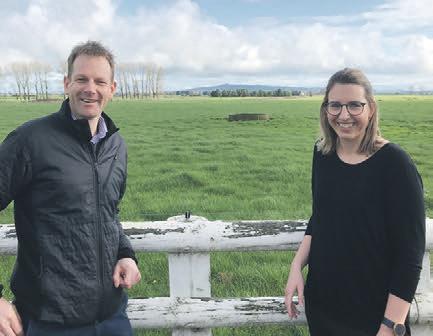
“It’s about supporting farmers through their change journey and in uencing government and regional leaders to help ensure there’s practical policy in place. “A lot has been achieved as a result of all this great work. It’s now widely recognised that catchment groups are the way forward for meaningful change. anks to all the work farmers have already been doing, the dairy sector is progressing well along the environmental change journey.” e sector is committed to improving water quality outcomes and farmers continue to make signi cant positive progress in reducing environmental footprint.
“ ere is still work to be done and DairyNZ has an extensive range of initiatives underway to improve water quality,” says Dr Burger. is includes researching mitigation tools such as constructed wetlands on farms, to treat contaminants before they enter waterways.
DairyNZ also works with research organisations to identify water quality issues at a catchment level and uses science to prioritise on-farm actions that lead to signi cant improvements.
“We wouldn’t be where we are without DairyNZ support,” Melissa says.
Improving water quality is a priority for the wider dairy sector, too. rough the Dairy Tomorrow strategy, the sector is committed to protecting and nurturing the environment for future generations. As part of this commitment, dairy sector partners are supporting farmers to develop farm environmental plans to improve water quality outcomes. As a result of this initiative, more than 5000 dairy farmers now have a farm plan which include speci c actions to address local environmental risks.
Phone Felicity today :07 578 0030 or email office@thesun.co.nz

For more information about the dairy sector’s commitment to improving water quality please visit dairytomorrow.co.nz


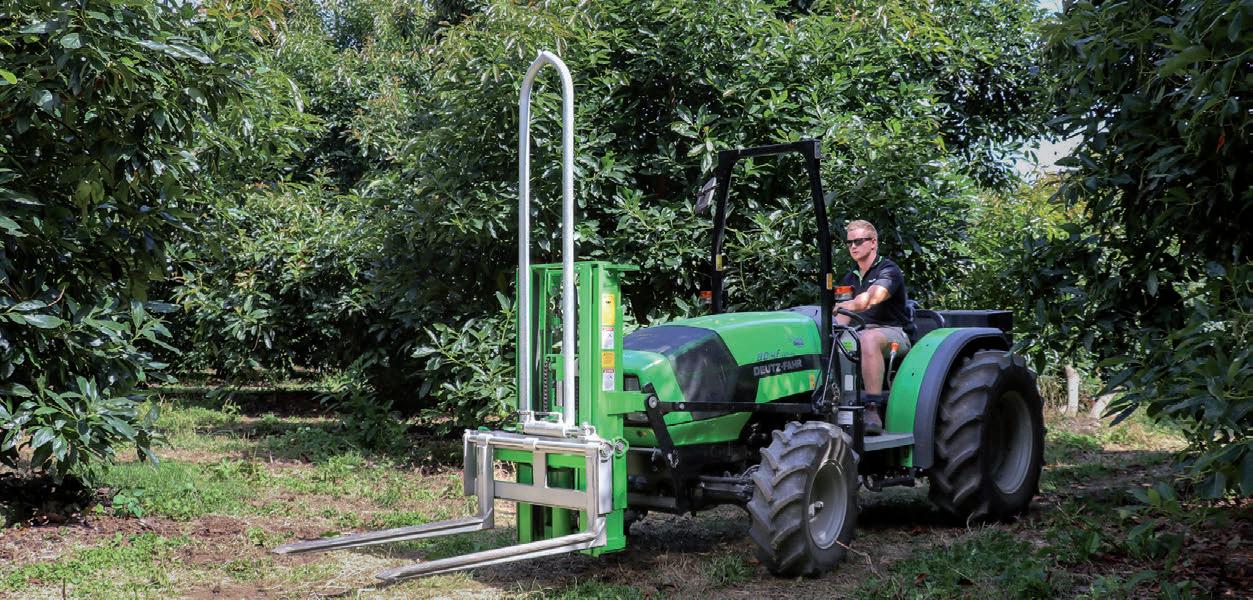

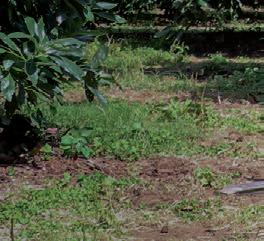
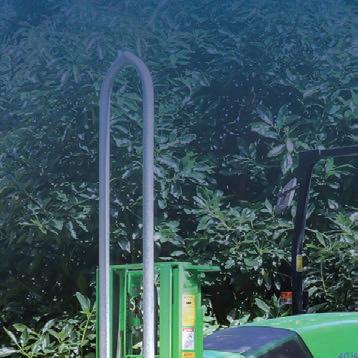
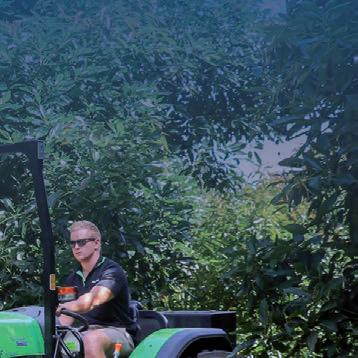



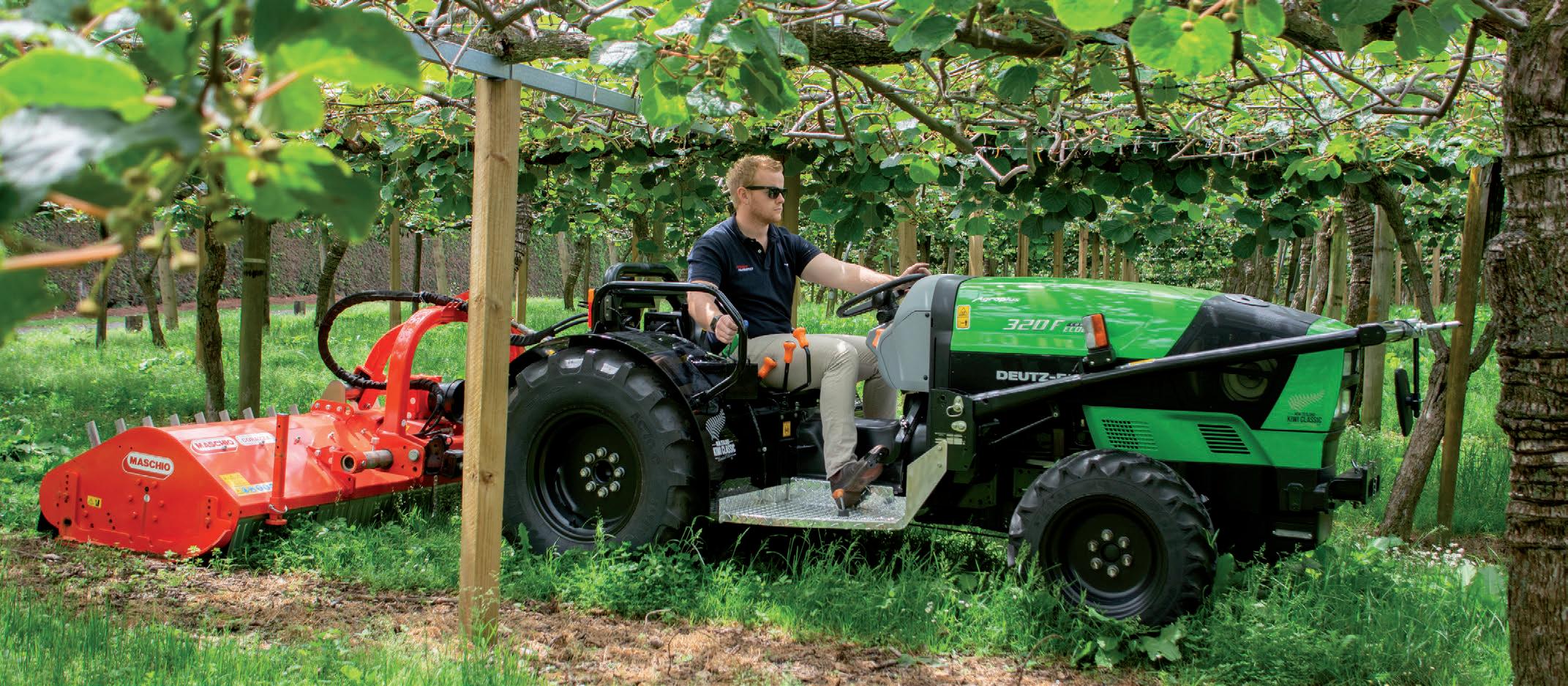

















When you live in a place long enough, you know the nature of the land – and you remember its history.
Ex-Hawke’s Bay local Vivienne Shaw gives a personal account of the land she grew up on and spent most her life – sharing her thoughts on Cyclone Gabrielle’s devastation to the region.

Alongside her husband of 60 years, Barrie Shaw, Vivienne enjoyed a rural lifestyle in Ongaonga – a central village of Hawke’s Bay.
Now living locally in Welcome Bay, Vivienne lived in the Hawke’s Bay for a total of 44 years.


e pair still have many family and friends living in the region and Vivienne says they are all doing okay after the cyclone hit last month.
Her nephew, who lives in Latham St, Napier “had the presence of mind to drive his big 4x4 to the top of a hill where he could get cell phone coverage”.
“He rang me on that afternoon to say that they were ne.”



Vivienne, 81, and Barrie, 84, were both born after Napier’s 1931 earthquake. “But Barrie does remember the aftermath of it,” says Vivienne. “It damaged a lot of the land and the buildings of the time. en in 1938, more particularly there was the incredible massive Esk Valley ood – which has just been repeated – which came from the hills above from the Taupo line, through the valley, straight out to sea – scoured it.”
Vivienne recalls a time from her childhood when she accompanied her father to visit a



friend of his. Her father’s friend had just built a new home in Marewa – a new suburb of Napier near Esk Valley. “Dad just shook his head,” says Vivienne.

“Dad just said: ‘I used to go shing here. is land only came up with the earthquake’.” “He just said: ‘No this is all wrong and they’ve forgotten that the water was once here –deep’.” She adds: “ is is the reason it’s such a fertile
area is because it’s on the wonderful river silt but that does actually tell you something. ere’s been a river there before.”
Vivienne says this fact is a surprise to many young and middle-aged people “but when you’re as old as us, you remember things that happened. ey may not have a ected us directly but indirectly –we learnt from them”.
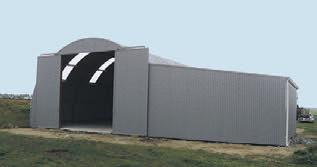

During their Ongaonga farm life days, Vivienne and Barrie lived in their home that was converted from a butter factory. “It was built in 1898 and it was built of kauri up on a massive concrete slab. “ e old-timers built properly so we were above a ood line,
and down probably two metres below us was the rest of our section which ran down to a little creek.”
Vivienne says these babbling brooks would turn into “raging torrents” when there was heavy downfalls – with water owing down from Hawkes Bay’s Ruahine and Wakarawa Ranges. “So intermittently, sometimes twice-a-year or once every two years, the whole bottom half of our four acre block would be covered in one metre and a half of water and that was just runo from rain in the ranges.”
As Vivienne and Barrie’s home was up on a concrete six inch-wide concrete wall, she says: “Although the water rose up that, it never ever breached inside the property in which we lived but people forget”.


On Cyclone Gabrielle’s devastation, Vivienne is devastated for all the people she knows “and all the people I don’t know, but I think that the engineers and the architects probably draw up very good plans but when tenders go out, the lowest one is accepted”.
“If it’s a council job or a government job, they are allowed to build to their own standards and not the standard that has been prescribed by the experts. Plus we have houses that do not withstand a ood of water. ey should never be on the land that’s been consented.”
“I just know that we’re woefully short of infrastructure to withstand anything that is out of the ordinary…people don’t understand, or they underestimate the power of natural disaster.
“It’s a tragedy that didn’t need to happen is what I’m saying.”